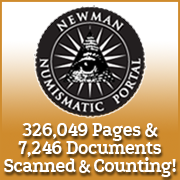
About UsThe Numismatic Bibliomania Society is a non-profit organization devoted to the study and enjoyment of numismatic literature. For more information please see our web site at coinbooks.org SubscriptionsThose wishing to become new E-Sylum subscribers (or wishing to Unsubscribe) can go to the following web page link MembershipThere is a membership application available on the web site Membership Application To join, print the application and return it with your check to the address printed on the application. Membership is only $20 to addresses in the U.S., $25 for First Class mail, and $30 elsewhere. For those without web access, write to: Terry White, Treasurer
AsylumFor Asylum mailing address changes and other membership questions, contact Terry at this email address: terrywhite5475@yahoo.com SubmissionsTo submit items for publication in The E-Sylum, just Reply to this message, or write to the Editor at this address: whomren@gmail.com BUY THE BOOK BEFORE THE COINSale Calendar |
- WAYNE'S WORDS: THE E-SYLUM JULY 17, 2016
- ADDITIONAL NBS BENEFIT SALE LOTS ANNOUNCED
- NEW BOOK: COUNTERFEITING AND TECHNOLOGY
- NEW BOOK: SAMPLE SLABS, 2ND EDITION
- EL SITIO NO. 19 PUBLISHED
- NEWMAN PORTAL DIGITIZES THE SHEKEL
- CHAPMAN-WEYL 1804 DOLLAR CORRESPONDENCE
- THE RARE AND IMPORTANT 1884 WEYL CATALOG
- 2016 ANA YOUNG NUMISMATIST LITERARY AWARDS
- NOTES FROM E-SYLUM READERS: JULY 17, 2016
- DAVID SUNDMAN AWARDED DEALER OF THE YEAR
- MORE ON DEALER HARVEY RISSMILLER
- JOSEPH HOOPER (1833-1919)
- PHOTOS OF STEPHEN NAGY
- MEDIALIA EXHIBITS HIGHLIGHT MODERN MEDALS
- MORE ON THE GOLD HENRY CLAY U.S. MINT MEDAL
- ALDRICH-VREELAND EMERGENCY CURRENCY OF 1914
- MACERATED CURRENCY SCULPTURES
- WAYNE'S NUMISMATIC DIARY: JULY 17, 2016
- NEW YORK’S USED BOOK STORES THRIVING
- SELECTIONS FROM GEOFFREY BELL 2016 RCNA SALE
- SELECTED SCOTTISH BANKNOTES FROM PAM WEST
- THE COINAGE OF PERGAMON
- THE IMPERIAL FAMILY ON ROMAN COINAGE
- BANK OF ENGLAND PROMOTES NEW POLYMER NOTE
- STUDY SHOWS POLYMER BANKNOTES RETAIN FINGERPRINTS
- BENNY BUCKS: MYSTERY DONOR HIDES $100 BILLS
- FBI CLOSES D.B. COOPER CASE
- FEATURED WEB SITE: THE BODE MUSEUM
Click here to access the complete archive
To comment or submit articles, reply to whomren@gmail.com
WAYNE'S WORDS: THE E-SYLUM JULY 17, 2016
New subscribers this week include: Chris Frazier, courtesy of John and Nancy Wilson, and Steve Schroeder. Welcome aboard! We now have 1,993 subscribers.
This week we open with some new NBS Benefit Auction lots, two new books, a new periodical, and the latest additions to the Newman Numismatic Portal.
Other topics this week include the Dexter 1804 dollar, the 1884 Weyl catalog, Joseph Hooper, D. B. Cooper, Harvey Rissmiller, 1914 emergency currency, Roman coinage, counterfeiting technology, fingerprints on polymer banknotes, and Ludger Gravel (who was NOT a character on The Flintstones).
To learn more about numimatic biblomania, Hans Schulman at the Farouk sale, sample slabs, ranch tokens, the gold Henry Clay mint medal, macerated currency sculptures, trench art jewelry, Benny Bucks, and the oft-misunderstood ant-nose coinage of ancient China, read on. Have a great week, everyone!
Wayne Homren
Editor, The E-Sylum
ADDITIONAL NBS BENEFIT SALE LOTS ANNOUNCED

13. NUMIMATIC BIBLOMANIA 203. The original hanging sign from the NBS club booth at the 1989 Pittsburgh ANA Convention. Yep, that’s the way it’s spelled! 44 inches wide, 7 inches high, two holes at top for suspension. The spelling is inadequately, if humorously, corrected in black ink. Donated by Wayne Homren, who notes: “[John] Burns and I had endless fun with the sign and I think it would bring some grins at the meeting.” It certainly elicited a smile when your cataloguer first saw it in 1989, before an unknown grammarian saw fit to add a puny “S” and a puny “I” between the appropriate 2 inch high, bold sans serif letters.
14. FAROUK AUCTION • Cairo, Egypt • FEBRUARY 24th to MARCH 6th, 1954. A fascinating printed flyer distributed by Hans M. F.
Schulman. 6 by 9 inches. The first your cataloguer recalls having encountered. As is well-known, Hans Schulman was owed a large sum of
money by the Egyptian Government at the time and he rather desperately endeavors here to redeem the credit due him by actively buying coins
on commission at the sale: “PLEASE CONTACT ME IMMEDIATELY IF YOU ARE INTERESTED IN MY SERVICES…”
Donated by Wayne Homren.
15. TWO BOWERS AND MERENA AUCTION SALE POSTERS FROM THE 1989 ANA SALE OF THE DR. NELSON PAGE ASPEN SALE. Both incorporate the
pictorial front cover of the catalogue, below which one provides information on the five sale Sessions and the other lists various Lot
Pick-Up days. Both 9.75 inches wide on dark green card stock, approximately 25 and 21 inches tall.
Donated by Wayne Homren
To read the earlier E-Sylum article, see:
NBS BENEFIT SALE AT ANA CONVENTION
(www.coinbooks.org/esylum_v19n28a02.html)

NEW BOOK: COUNTERFEITING AND TECHNOLOGY
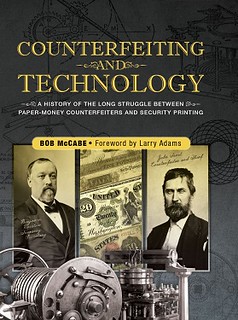 This winter, the long-anticipated story of paper-money counterfeiting by historian Bob McCabe will make its debut. Counterfeiting
and Technology: A History of the Long Struggle Between Paper-Money Counterfeiters and Security Printing is an adventurous monument to the history
of paper money and, most importantly, to the technology that created it.
This winter, the long-anticipated story of paper-money counterfeiting by historian Bob McCabe will make its debut. Counterfeiting
and Technology: A History of the Long Struggle Between Paper-Money Counterfeiters and Security Printing is an adventurous monument to the history
of paper money and, most importantly, to the technology that created it.
At the ANA’s World’s Fair of Money in Rosemont, Illinois, last year, I had the privilege of attending a Society of Paper Money Collector’s meeting, during which a presentation on Confederate paper money was delivered. Afterward the floor was opened to a Q&A session, during which one particular question caught my ear: “When will a book on the history of counterfeiting in America be released? Nothing like that really exists right now.” At the time Counterfeiting and Technology was in production with Whitman Publishing, and I could barely contain my excitement as I answered the question, stating that the release of just such a book would be forthcoming in the following year.
McCabe has dedicated two decades to the creation of this text, falling in line with the requirements of bank-note creation: to produce the “highest form of the art.” Author Daniel Stadtfeld says of the book: “This author has gone to extreme lengths to try to present the most accurate account possible. Robert McCabe is an individual that will not settle for anything less than the truth in its best available form.”
Collectors, historians, and researchers will certainly not be disappointed. Within Counterfeiting and Technology are tales spanning from the first paper money ever known to be printed during China’s Tang dynasty to the technology’s journey from East to West. Readers will learn step-by-step about the art and advancement of line engraving, mechanical engraving, paper-making, ink-making, natural anti-counterfeiting measures, and the modern security printing that goes into making bank notes what they are today. At the same time, the text is rich with daring heists, escapes, and manhunts as the battle between counterfeiters and authorities grew more and more complex with the technology at hand.
While the chemistries and inner-workings of printing are laid out alongside diagrams of printing presses through the ages, this is not a tale exclusively for the scientifically minded—although those searching for scientific analysis will not be in want. The book is bisected into processes and people, the art of paper making, and those who did the work. Machines and chemistries related to paper making are carefully explained so that their functions are easily understood, bringing a whole new life to the paper we use on a daily basis. The advancements that finally led to the bank-note–company era, particularly in England and in the United States, are brought forward so that their contributions too can be listed, from small companies to the large “merger” of the American Bank Note Company after 1858.
Running parallel to the analysis of the technology and chemistries involved are stories and histories of the counterfeiters who perpetrated the work, as well as those who strove to stop them. The evolution of the Secret Service and the Bureau of Engraving and Printing is covered, as are undercover investigations, bold court defenses, and unbelievable and even humorous escapes. Fraudsters, mostly unknown or unrecognized for their own dishonest cleverness, are finally brought to light by portraits from the National Archive and the U.S. Secret Service Archives. These rarely-before-seen criminals are placed alongside pictures of Bureau and Secret Service directors, as well as full-color illustrations of the time.
Any student of paper money should have this book to better understand the very foundation of the pieces of history they collect. Author McCabe states: “There are both villains and heroes in this story, and each played a role in advancing the technology of paper money. I think there is a real need for a single-reference work that sets down the basic facts of how the bank-note industry was created and evolved in the last century to become a sophisticated technology producing notes of high artistry.”
McCabe continued: “Not only did I visit most of the major libraries in the Eastern states, including the Library of Congress, I also met an ex-Navy officer who took me into the basement of the Confederate Museum to see what was left of one of the presses that was used to print Confederate currency during the rebellion. While in New York, I learned to play one library against another, because no one place has all the ‘good stuff.’ The New York Public Library has a print-room to die for, and the National Union Catalog, which helps to plan your visits to other libraries, but the Historical Society of Pennsylvania was the most surprising and rewarding discovery. It holds many of the 18th- and early 19th-century documents I was searching for, and I returned the next year to dig for even more treasures. Start with what you can get and build on that knowledge. Answer the questions your readers will want to know. And don’t hesitate to put ink to paper.”
To read the complete article, see:
Bob McCabe’s Book on
Counterfeiting To Be Released This Holiday Season
(http://news.coinupdate.com/bob-mccabes-book-on-counterfeiting-to-be-released-this-holiday-season/)
THE BOOK BAZARRE
NEW BOOK: SAMPLE SLABS, 2ND EDITION
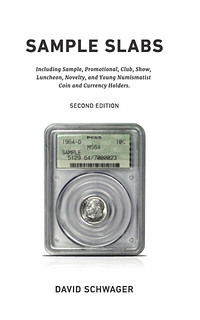 Thank you for mentioning my book Sample Slabs when it premiered last year. Showing the kind of readers you have, I received more
inquiries on this niche topic from the notice in the The E-Sylum than I did from a mention in COINage and a review in The
Numismatist. Roughly defined, a sample slab is a certified coin holder given away by a grading service as an example of its work. Although
originally free gifts to collectors and dealers, sample slabs have an active secondary market, with scarce types earning $100 or more.
Thank you for mentioning my book Sample Slabs when it premiered last year. Showing the kind of readers you have, I received more
inquiries on this niche topic from the notice in the The E-Sylum than I did from a mention in COINage and a review in The
Numismatist. Roughly defined, a sample slab is a certified coin holder given away by a grading service as an example of its work. Although
originally free gifts to collectors and dealers, sample slabs have an active secondary market, with scarce types earning $100 or more.
I hoped that, when I wrote the book, people would send me details on items in their sample slab collections not included in the catalog. This happened and, when the modest first printing of 100 copies sold out in four months, a second edition was more worthwhile than a second printing. That second edition is now at the printer with a scheduled debut August 9 at the Anaheim ANA show.
Although the second edition is much larger (445 pages to 620 pages, 580 listings to 760 listings, and 600+ photos to over 900 photos) the price went up only $2 to $26. A presale offer for $21 plus shipping (or less for the PDF) is at SampleSlabBook.com. As a side note, the first edition now sells on eBay for $50 - $60, or more than double its issue price.
Researching a largely unexplored field like sample slabs has been rewarding, with new discoveries appearing regularly. Thanks to readers of the Sample Slab Update newsletter and my ongoing market research, the catalog grew by 180 listings in one year, meaning new types were discovered at the rate of about one every two days. One of the challenges of the project was knowing when to stop. Considering the amount of work involved, I don’t plan to make a third edition anytime soon. I continue to research, however, and welcome information and photos.
For more information, or to order, see:
www.SampleSlabBook.com (https://sites.google.com/site/sampleslabbook/)
To read the earlier E-Sylum article, see:
NEW BOOK: SAMPLE SLABS (www.coinbooks.org/esylum_v18n25a05.html)
EL SITIO NO. 19 PUBLISHED
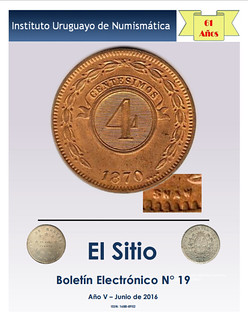 “El Sitio” N° 19 contains, in its 32 pages, four numismatic articles about different issues.
“El Sitio” N° 19 contains, in its 32 pages, four numismatic articles about different issues.
The first article, “Las monedas paraguayas de 1870: ¿quién era Shaw?” (“The Paraguayan coins of 1870: who was Shaw?”) by
Horacio Morero, studies Shaw as the contractor for the minting of these coins, including the genealogy of his family. The relevant
conclusion is that Shaw wasn’t the “engraver” of the 1870 Paraguayan coins as some books tell us, but the “contractor”. The cover of “El
Sitio” N° 19 shows indeed the picture of the 4 centesimos 1870 Paraguay coin with the inscription SHAW at five o'clock in the
border of the flan.

The second one, by Nicolás Santerini, presents two unknown bimetallic Uruguayan trials: 1994 $ 5 and 1994 $ 10 struck probably in Argentina.
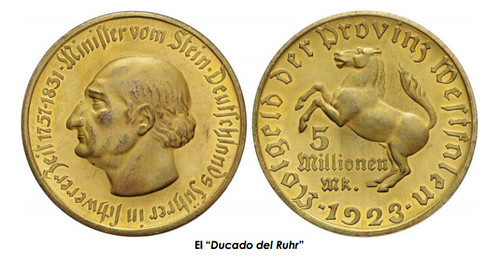
Sebastián Aguilera, in the third article tells us about the emergency money issued in the Province of Westfalia, showing interesting pictures of those “Notgeld” coins.
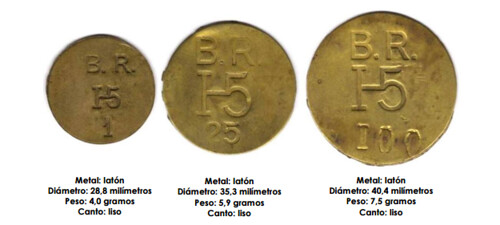
The last article, also written by Horacio Morero, is about shearing tokens. Here, the author follows the path of his previous work identifying ranch tokens.
In addition, “El Sitio” gives us information about the “Jornadas Uruguayas de Numismática 2016” that will take place on October 15 th and 16 th at the Holiday Inn Hotel in Montevideo, Uruguay.
To read the complete issue, see:
http://iunuy.org/flop01/wp-content/uploads/elsitio/ElSitioN%C2%BA19.pdf
THE BOOK BAZARRE
NEWMAN PORTAL DIGITIZES THE SHEKEL
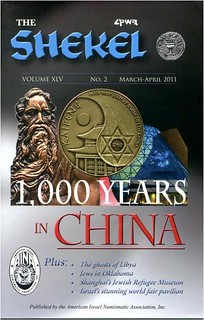 The Newman Numismatic Portal now includes The Shekel, from 1968-2015. The journal of the American Israel Numismatic Association,
The Shekel covers a wide array of topics, from ancient and Biblical coins to modern numismatic items connected with Jewish figures.
Writers include Benjamin Weiss, Mel Wacks, Howard Berlin, and many others.
The Newman Numismatic Portal now includes The Shekel, from 1968-2015. The journal of the American Israel Numismatic Association,
The Shekel covers a wide array of topics, from ancient and Biblical coins to modern numismatic items connected with Jewish figures.
Writers include Benjamin Weiss, Mel Wacks, Howard Berlin, and many others.
The Jewish-American Hall of Fame Newsletters document one of the longest running series of art medals in the United States. Beginning in 1969 the Hall of Fame has annually honored a prominent Jewish figure with a medal, each well documented in the newsletter for that year. Among the honorees are Albert Einstein, George Gershwin, and Ruth Bader Ginsburg. Medals can be difficult to collect with no standard guide – this is a notable exception. Many thanks to Mel Wacks for his assistance with this content.
Newman Portal content is text searchable, and a sample search for “Rebecca Gratz” (an interesting character with several oblique numismatic connections) uncovered a healthy number of matches within these two publications.
Link to The Shekel on the Newman Portal:
https://nnp.wustl.edu/library/publisherdetail/511938
Link to the Jewish-American Hall of Fame Newsletters:
https://nnp.wustl.edu/library/publisherdetail/512652
CHAPMAN-WEYL 1804 DOLLAR CORRESPONDENCE
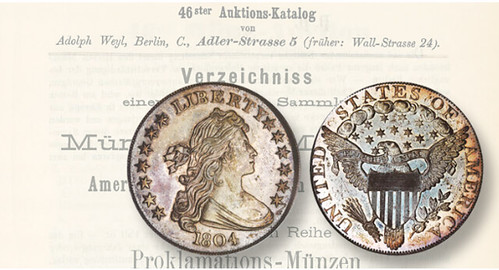
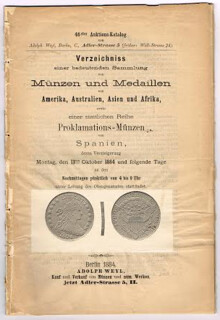 I have a few comments about the recent Coin World article appearing on pages 38-41 of the July 18, 2016 issue, “A Great Rarity Makes
its World Debut,” which pertains to the Dexter 1804 Dollar and the 1884 Weyl catalog. When I purchased my copy of the Weyl catalog from George Kolbe
at the 1996 Denver ANA convention I had no idea how very rare this catalog is – just 3 or 4 known. George told me that Eric Newman came to his table
to see the catalog, but I had already purchased it.
I have a few comments about the recent Coin World article appearing on pages 38-41 of the July 18, 2016 issue, “A Great Rarity Makes
its World Debut,” which pertains to the Dexter 1804 Dollar and the 1884 Weyl catalog. When I purchased my copy of the Weyl catalog from George Kolbe
at the 1996 Denver ANA convention I had no idea how very rare this catalog is – just 3 or 4 known. George told me that Eric Newman came to his table
to see the catalog, but I had already purchased it.
I was merely collecting items pertaining to the Dexter Dollar saga while piecing together its story, a few years after I acquired two original artworks James V. Dexter commissioned in 1887 in honor of the coin. It was very fitting that I purchased the Weyl catalog from George in Denver, as that is where J.V. Dexter resided until his passing in 1899. Dexter also spent a great deal of time in Leadville, Colorado.
At the next ANA convention in Denver, in 2006, I gave a lecture about the coin’s history for the Maynard Sundman Lecture Series. I’m extremely grateful to Brent Pogue who brought the actual Dexter Dollar to the convention so it could be displayed for my lecture, along with my collection of Dexter Dollar documents and memorabilia, including the Weyl catalog.
One evening during that week I set out to find where Dexter’s mansion stood. To my surprise, the mansion, which was torn down in the 1930s, used to stand at the other end of the convention center from where our convention took place! The coin had come home. Earlier that year I also spent two days in Dallas with Brent and Richard Burdick where we examined, in their “raw” state, both 1804 silver dollars Brent owns. What a treat that was - thank you once again Brent and Richard!
Regarding the letterpress copies of the Chapmans’ 1884-1885 letters I discovered in the ANS archives in 2013 while doing research for my book, The Dollar of 1804 – The U.S. Mint’s Hidden Secret, the recent Coin World article stated, “there may be some small room for doubt about the Chapmans’ motivation for copying these letters.” I believe that doubt originated with a mere rumor started by Edouard Frossard in an 1885 letter to James Dexter in which Frossard insinuated that the Chapman brothers “claim to have bought [the coin] there,” meaning in Germany, from Weyl.
That rumor was given further elevation in the 1962 book, The Fantastic 1804 Dollar, by Eric Newman and Ken Bressett, in which they stated, “The real truth about the mix-up of the photographs can be reconstructed with a little imagination.” They went on to spin a tale of how the Dollar was planted or laundered through the Weyl sale to give it a “fancy foreign pedigree,” while its source was really in Philadelphia.
Given the high regard we all have for Eric and Ken, and that most numismatists believe they answered all the questions about 1804 silver dollars in their book, and that very few people research 1804 Dollars, that tale has more or less become accepted as fact – that the Dexter Dollar was planted in the 1884 Weyl sale as a cover-up for obtaining it in Philadelphia.
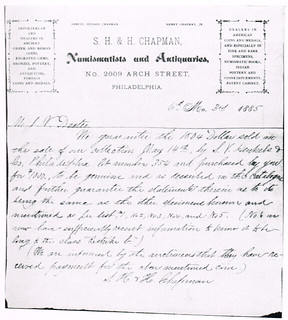
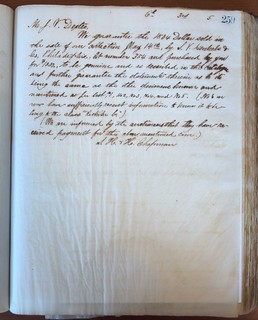
Left: Mehl Dunham Catalog letter (image credit: Mark Ferguson)
Right: Letterpress copy June 3, 1885 (image credit: ANS)
I believe the letterpress copies that I discovered in the ANS archives convincingly put this matter to rest, once and for all. I have discussed the Chapmans’ letterpress copies at length with David Hill, archivist and librarian of the ANS, and Dr. Ute Wartenberg Kagan, executive director of the ANS. They have each expressed to me that they believe, as I do, that the letterpress copies are real and have not been faked. Here are some reasons we believe they’re the real thing:
1. The letterpress copies were private records of S.H. and H. Chapmans’ business correspondence, not meant for publication.
2. The letterpress copies were bound in books in chronological order by date along with copies of other regular, day-to-day business correspondence.
3. The bound letterpress copies stayed with the Chapman family until being donated to the ANS in 2002.
4. The letters were written over several months, between September 12, 1884 and February 13, 1885.
5. There was a language barrier between the Chapmans and Weyl, regarding English and German, and the translations of particular words and sentences and their meanings. Some were misconstrued.
6. An obvious problem arose in the transaction; the Chapmans expected to obtain the coin before sending the money and Weyl wanted the money before sending the coin. The solution was to hire an agent, Charles H. Meyer, German Consul in Philadelphia, to receive and disburse the money and the coin.
7. One letterpress copy, No. 259, can be matched to a photograph which appears in the 1941 W.F. Dunham catalog by B. Max Mehl, of a real letter written to J.V. Dexter on June 3, 1885, stating that the Chapmans guarantee the 1804 Dollar bought by Mr. Dexter to be genuine. All of the hand-writing and spacing of the letterpress copy match precisely that of the real letter photographed and illustrated in the Dunham catalog.
I hope this information and what’s published in my book, The Dollar of 1804 – The U.S. Mint’s Hidden Secret, is convincing evidence that the Chapman brothers legitimately purchased, what’s now known as the Dexter Dollar, from the 1884 Adolph Weyl sale in Berlin, Germany. My book can be purchased at www.1804Dollar.com. I wrote it to educate and to entertain.
The discovery of the Dexter specimen has been shrouded in mystery for 130 years. It likely appeared in a group lot in an 1879 auction by Adolf Weyl in Germany. The Chapmans bought it in 1884 from another Weyl auction with no pedigree and no guarantee of genuineness, though the book reveals that they had returned a coin to Weyl’s auction company previously for a refund, so they probably thought the risk was acceptable. They sold it in their own auction in 1885 to James V. Dexter, who proceeded to sue them in the belief, fostered by the Chapmans’ competitor Édouard Frossard, that it was a fake.
The shadowy discovery of the coin and other issues led many to suspect that the Chapmans got the coin in Philadelphia (from the Mint, Haseltine, Idler, or whom?) and planted it in the Weyl auction. Never mind that the 1804 dollars Haseltine was selling in those years were all Type IIIs, and the Dexter coin is a Type I. Lacking any evidence to the contrary, Newman and Bressett repeated this then-current notion in their 1962 book, The Fantastic 1804 Dollar. Ferguson, however, has uncovered enough evidence that the Chapmans did NOT plant the coin to convince most other than ardent ... conspiracy theorists.
To read the complete article, see:
Out of nowhere: Dexter 1804 dollar
makes first appearance (www.coinworld.com/news/us-coins/2016/07/brent-pogue-great-rarity-global-debut.all.html)
To read the earlier E-Sylum articles, see:
DEXTER 1804 DOLLAR NOTEBOOK SOUGHT (www.coinbooks.org/esylum_v08n18a06.html)
MARK FERGUSON, H.O. GRANBERG, AND THE DEXTER 1804 DOLLAR
(www.coinbooks.org/esylum_v16n08a10.html)
NEW BOOK: THE DOLLAR OF 1804 (www.coinbooks.org/esylum_v17n16a03.html)
BOOK REVIEW: THE DOLLAR OF 1804 (www.coinbooks.org/esylum_v17n22a09.html)
BOOK REVIEW: THE DOLLAR OF 1804 (www.coinbooks.org/esylum_v17n26a08.html)

THE RARE AND IMPORTANT 1884 WEYL CATALOG
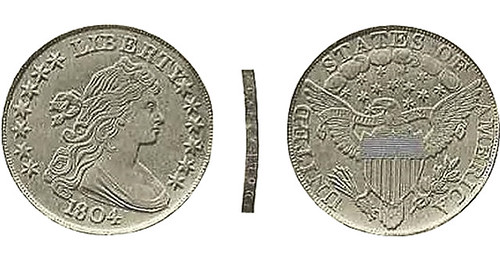
Prominent coin dealer Adolph Weyl held his 46th auction in Berlin, beginning on Oct. 13, 1884, and concluding the following day. Although the sale mainly featured world coins, lots 94 to 387 were United States issues, including the first European auction appearance of an 1804 Draped Bust dollar, in lot 159. The lot was purchased by the Chapman brothers (Henry and Samuel H.) for a low price of $216 and sold by them to Colorado collector James Vila Dexter for a staggering $1,000 the following year.
The huge profit the Chapmans realized and the mysterious origin of the coin caused Dexter to become suspicious of its authenticity. He filed suit against the Chapman brothers for fraudulently selling the coin, which he believed to be a recent restrike, and was only mollified after a prolonged legal scuffle, when affidavits of authenticity signed by various Mint officials convinced him the coin was genuine. Misconceptions about the sale have dogged numismatic researchers for the last 130 years.
No copy of the Weyl catalog was available to Eric P. Newman and Ken Bressett when they published their landmark study, The Fantastic 1804 Dollar, in 1962. On page 92 of that remarkable work, they theorized that the Chapman brothers had laundered the coin through the Weyl auction, sending him an electrotype of the coin to photograph for the catalog, while really holding the actual coin in this country and authorizing him to outbid any other bidders at the sale on their behalf.
The question of why no modern researcher had ever bothered to compare the Weyl plate to the actual coin continued to trouble Newman, however. He soon found that the catalog was virtually unobtainable. After a five-year search, he finally located a copy in the Austrian National Numismatic Collection in Vienna. After studying the image, he concluded that the coin in the picture was really the Dexter dollar, and not an electrotype after all. The extra “die cracks” in the image were actually thin cracks in the plaster cast used for the photograph, not on the surface of the coin, and the picture shows some diagnostic marks that conclusively identify the Dexter dollar. He also concluded that Weyl must have had the actual coin to photograph, as he felt the picture of the edge lettering could not be reproduced from an electrotype or plaster cast.
Rubin suggests Weyl may have photographed the edge lettering of the coin to explicitly show that it was not a plain edge restrike from 1858 and did not have the seam on the side one might expect from an electrotype. This illustration is the earliest example of a photographic image of the edge lettering on any coin we are aware of, but it is possible that some earlier plates exist.
Newman published his findings in the March 1970 issue of The Numismatist.
Rarity of the Catalog
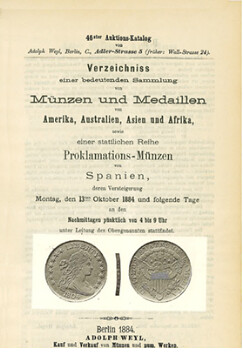 That a truly great collector like D. Brent Pogue had never seen a copy of the Weyl catalog is some indication of its rarity. There was no
copy in the libraries of Harry Bass, John Ford or Armand Champa, and there is no example in the ANS Library. George Kolbe, perhaps the foremost
dealer of numismatic literature in the 20th century, was in business for 27 years before he handled an example. He reported he had “half-serious
doubts about its very existence” before a copy surfaced in lot 370 of his Fourteenth Annual Joint Kolbe-Spink Auction of Dec. 9, 1995. Kolbe noted
this copy was originally part of a “bound volume of period European sales from the library of the Antiquarian and Numismatic Society of Montreal and,
quite likely, it was originally part of the library of Robert Wallace McLachlan which was transferred to the Chateau de Ramezay in 1922.”
That a truly great collector like D. Brent Pogue had never seen a copy of the Weyl catalog is some indication of its rarity. There was no
copy in the libraries of Harry Bass, John Ford or Armand Champa, and there is no example in the ANS Library. George Kolbe, perhaps the foremost
dealer of numismatic literature in the 20th century, was in business for 27 years before he handled an example. He reported he had “half-serious
doubts about its very existence” before a copy surfaced in lot 370 of his Fourteenth Annual Joint Kolbe-Spink Auction of Dec. 9, 1995. Kolbe noted
this copy was originally part of a “bound volume of period European sales from the library of the Antiquarian and Numismatic Society of Montreal and,
quite likely, it was originally part of the library of Robert Wallace McLachlan which was transferred to the Chateau de Ramezay in 1922.”
David Fanning informs us that this remains the only copy the firm of Kolbe & Fanning has offered at auction, but Ferguson reports he purchased a copy privately from George Kolbe’s booth at the 1996 American Numismatic Association convention. Charles Davis, an equally respected East Coast numismatic literature dealer, believes he sold a copy of this catalog privately at one time, but he has never offered one at public auction.
The Oct. 13, 1884, Weyl sale is essential to our understanding of the history of the Dexter 1804 dollar, one of the most important coins in American numismatics. The elusive nature of the catalog made it difficult for numismatists to properly study the document in the past, leading to much confusion and adding to the lack of confidence 19th century collectors felt in all 1804 dollars, after the “restrike” abuses of the late 1850s. These misunderstandings led to unfortunate damage to the reputations of some 19th century coin dealers, like the Chapmans, who seem to have been innocent of the dishonest business practices of other dealers (like their mentor, John W. Haseltine), at least on this occasion.
We hope this study has cleared up some of the misconceptions about the Dexter dollar. A better understanding of photographic techniques of the era should also clarify some questions about the image of the coin in the catalog. The 1884 Weyl catalog remains one of the rarest, most important, and enigmatic documents in the numismatic literature corpus.
To read the complete article, see:
Out of nowhere: Dexter 1804 dollar
makes first appearance (www.coinworld.com/news/us-coins/2016/07/brent-pogue-great-rarity-global-debut.all.html)
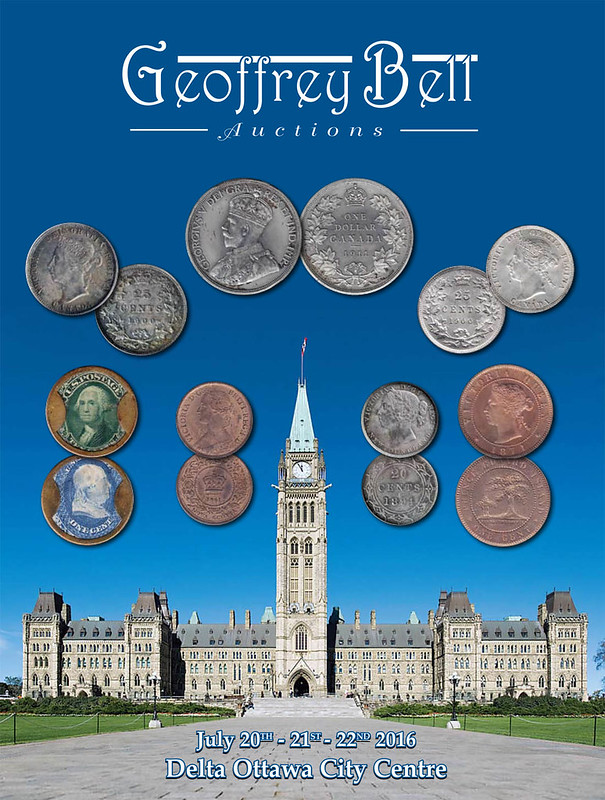
2016 ANA YOUNG NUMISMATIST LITERARY AWARDS
Congratulations to the 2016 ANA Young Numismatist Literary Award Winners
Each year the American Numismatic Association recognizes young writers through the Young Numismatist Literary Awards, funded by Whitman Publishing. Awards of up to $1,000 are given in three age groups named after Whitman authors and longtime hobby leaders Bill Fivaz (entrants aged 8–12), Q. David Bowers (ages 13–17), and Kenneth Bressett (ages 18–22).
First-place winners receive a $500 cash prize and a $500 voucher to build a personal library of numismatic books from Whitman Publishing. Second place receives a certificate and a book voucher for $200. Third place receives a certificate and a $100 book voucher.
“Numismatics is a rich field for anyone interested in research and writing, uncovering long-forgotten facts, diving into history, studying art and science, solving mysteries, and exploring the world,” said Whitman publisher Dennis Tucker. “Today’s young writers might be the next generation of numismatic authors, and we’re pleased to encourage them.”
Congratulations to these Young Numismatists for their winning articles in the 2016 competition.
FIVAZ AWARD (ages 8–12)
1st place: Kelly Barker of Delaware, for “That’s Odd”—a reflection on half cents, two-cent pieces, and other odd coin denominations.
2nd place: Alexander Mous of Washington, for “Progressive Times in Japan”—a study of Japanese money in the era of the samurai.
3rd place: Kellen Hoard of Washington, for “5 Steps to Encourage Children to Become Numismatists”—a formula for adding more young
collectors to the hobby’s ranks.
BOWERS AWARD (ages 13–17)
1st place: Benjamin Mous of Washington, for “The Tale of Two Islands”—an illustrated comparison of the coinages of Lundy and Jersey.
2nd place: Calvin Pineda of Idaho, for “Joseph A. Bailly: The Mint’s Mystery Man”—a biography of an obscure and unsung U.S. Mint coin
designer.
3rd place: Kenny Sammut of Pennsylvania, for “U.S. Minted Coins: Not Just for Americans”—a look at coins produced by the U.S. Mint for
other countries.
BRESSETT AWARD (ages 18–22)
1st place: Daniel Williams of Georgia, for “America’s Little Brother”—a study of the coins, in particular patterns, of Liberia, and their
American influences.
2nd place: Thomas Walker of Georgia, for “The Oft-Misunderstood Ant-Nose Coinage of Ancient China”—an exploration of these ancient coins
and their types.
3rd place: (no entry)
NOTES FROM E-SYLUM READERS: JULY 17, 2016
Churchill Photo Cartoon Parody
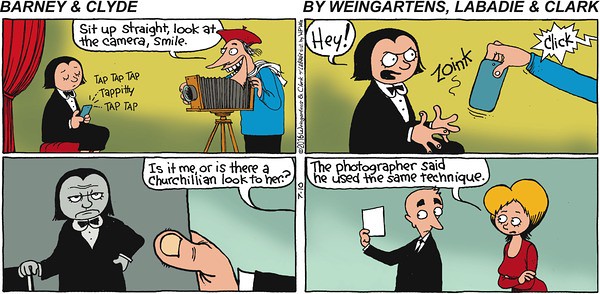
To read the earlier E-Sylum article, see:
CARTOON PARODIES FAMOUS KARSH CHURCHILL PHOTO
(www.coinbooks.org/esylum_v19n28a34.html)
The Moneyed Mouse
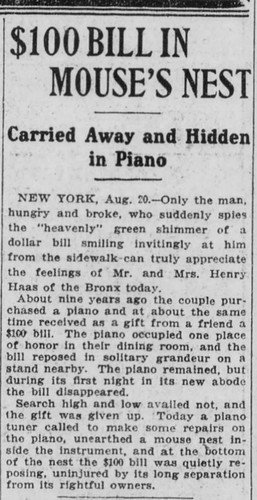 While looking for other things John Lupia came across this August 21, 1921 Boston Post story about a mouse with expensive tastes.
Thanks. -Editor
While looking for other things John Lupia came across this August 21, 1921 Boston Post story about a mouse with expensive tastes.
Thanks. -Editor
Amon Carter Paper Money Sales Sought
Jay Recher writes:
Did Sotheby's have a paper money auction for Amon Carter? Also, does anyone have a copy of Lyn Knight's Carter sale for purchase?

Archives International Auctions, Part XXXIV
U.S. & Worldwide Banknotes, Scripophily, Coins
and Security Printing Ephemera
July 26, 2016
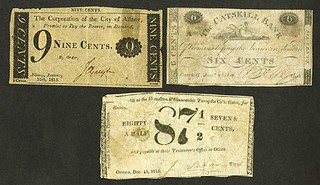
Click the links! Highlights include:
Lot 43: Deutsch-Asiatische Bank 1907 Peking Branch
Lot 44: Russo-Asiatic Bank, 1910 "Harbin Branch" Provisional Issue
Lot 405: Jefferson County Bank. Uniface Proof.
Lot 407: New York State War of 1812 Era Odd Denomination Scrip
Lot 434: C.S.A. 1864, $2, Vertical Half Sheet of 4 Notes.
Lot 481: Spanish-American War, $20, 3% Coupon Bond of 1898
Lot 645: Potomac Gold and Silver Mining Co., 1863 Stock Certificate.
Lot 789: American Bank Note Company, 1868 Stock Certificate
View the Virtual Catalog
Download the Catalog in PDF format
ARCHIVES INTERNATIONAL AUCTIONS, LLC
1580 Lemoine Avenue, Suite #7
Fort Lee, NJ 07024
Phone: 201-944-4800
Email: info@archivesinternational.com
WWW.ARCHIVESINTERNATIONAL.COM
DAVID SUNDMAN AWARDED DEALER OF THE YEAR
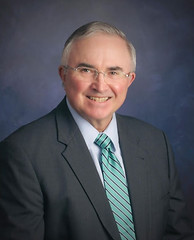 David Sundman Awarded ANA’S Harry J. Forman
David Sundman Awarded ANA’S Harry J. Forman
Dealer of the Year Award
Sundman also to be celebrated during Legacy Series, Member & Donor Reception
David Sundman, president of Littleton Coin Company in Littleton, NH, is the 2016 recipient of the American Numismatic Association’s Harry J. Forman Dealer of the Year Award. The award honors a professional numismatist who shows uncommon dedication to strengthening the hobby and the Association and displays exemplary ethical standards as a numismatic dealer.
Unlike many numismatists, David Sundman grew up with a mail-order stamp and coin business, which was founded by his parents, Maynard and Fannie. By age five, David was sorting bags of Indian Head cents by dates and was well on his numismatic voyage.
Working alongside his father, David became so captivated by the stories behind stamps and coins that he later earned a degree in history from Gettysburg College in Pennsylvania. After gaining business experience with a retail chain in the Washington, D.C. area, he joined the family collectibles firm, Littleton Coin Company, in 1972 and was named president in 1985.
“It’s a real surprise and honor to receive this award. However, the true ‘Dealer of the Year’ award should be shared with our entire Littleton Coin organization of more than 300 staff,” said David. “Over the past 70 years, we’ve gathered a talented group of people who continue diligently every day to make Littleton Coin a better company, which serves collectors all over the nation.”
A life member of the ANA, David is also a member of the Professional Numismatists Guild, a Fellow of the American Numismatic Society, and Treasurer of the Numismatic Bibliomania Society.
A prolific author, David is a current contributor to A Guide Book of United States Coins and a co-author of the best-selling book 100 Greatest American Currency Notes with Q. David Bowers.
David is a frequent presenter at ANA conventions and has received the organization's Century Club Award (1997), Exemplary Service Award (1997), Presidential Award (2001), Glenn Smedley Memorial Award (2001), and Medal of Merit (2003) for his contributions to the Association’s numismatic and educational programs.
Legacy Series Recognition
Sundman also will be recognized at the Anaheim World’s Fair of Money® during the Legacy Series, an event moderated by Editor-in-Chief
of The Numismatist, Barb Gregory. The event will honor and celebrate David, who has significantly impacted the numismatic community through
his vision, leadership, and trend-setting within the hobby.
Dealer Booster Award
Sundman also will receive this year's Dealer Booster Award on behalf of Littleton Coin Company during the Member and Donor Reception in
Anaheim. Littleton's membership efforts garnered 128 new ANA members.
Numismatic Bibliomania Society President Marc C. Ricard writes:
The NBS is proud to congratulate our longtime friend, David Sundman, on this prestigious award. His dedication to our organization, and the field of Numismatic Literature, has been tireless. He and his staff members at the legendary Littleton Coin Company have generously enriched the entire numismatic community, and for this, and all the unseen contributions over the years, it is our privilege to be his colleague.
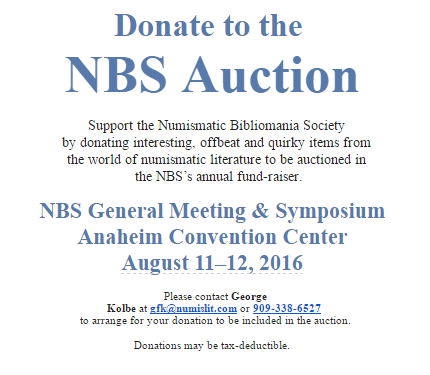
MORE ON DEALER HARVEY RISSMILLER
Dave Hirt writes:
The bio of Harvey Rissmiller was very interesting to me. I knew Harvey from his attendance at the meetings of the Reading Coin Club which I also attended. I lived in Phoenixville. The Reading club, founded in 1940, was the only coin club outside of Philadelphia in that area.
I remember him as an elderly man, thin, and not too tall. He always wore a rather thread-bare suit. He always sat up in the front of the club. I was told that he often traveled to New York to buy gold. I remember thinking that if people there saw that plainly dressed old man, they'd never think his pockets were full of gold coins.
It was quite a surprise to see Rissmiller's selling price list. I do not remember ever seeing any of his publications for sale.
I joined the Reading Coin Club in the early 1950s while still in high school. They would start with a short business meeting, then get right to the main event, the coin auction. the auction was extensive, sometimes lasting up to two hours. It was a great place for a beginning collector like my self. I bought common date Indian Head Cents for 3 cents each, circulated Columbian Half Dollars for 60 cents each. and so on.
Rare coins did not come up too often, but sometimes they did. I bought an 1864 3 Dollar gold piece for $35, but sold it for a $5 profit the same evening. Also I once bought an 1804 VG+ 1804 Quarter Dollar. The best buy I ever made was once when an estate was sold at the club. I bought a 1922 plain Lincoln cent red condition for $8.
I remember that Rissmiler would rarely bid. Probably he was a consignor, selling off excess stock, although I am not sure of that. I never went to Rissmiller's store. I was friendly with another dealer in the club, Cyrus Rhode who had a store on N. 6th Street. After I finished school, and started working, I bought many great coins from him. I could tell a lot of stories about Rhode.
To read the earlier E-Sylum article, see:
HARVEY RISSMILLER (1882-1963) (www.coinbooks.org/esylum_v19n28a12.html)
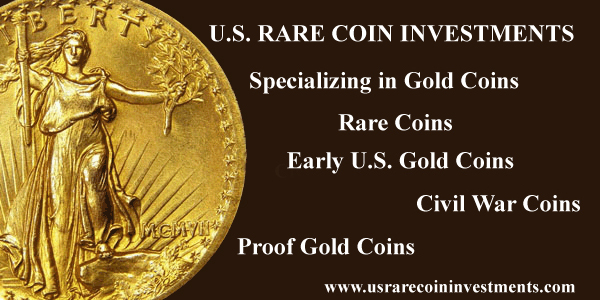
JOSEPH HOOPER (1833-1919)
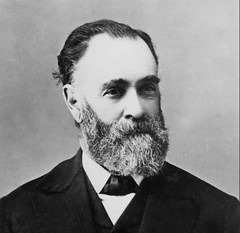 He was born at Plymouth, Devon, England on February 19, 1833, son of John Hooper (1796-) and Elizabeth Hooper (1786-1851). He was a direct
descent of the Bishop of Gloucester, England. He worked as an apprentice marble cutter in England. After the death of his mother Elizabeth his family
moved to America in September 1851 migrating to Detroit, Michigan. A few years later, in 1853, he settled in Port Hope, Northumberland, Ontario,
Canada, where he lived with his new American wife Annie Maria Pratt (1828-1901). They had six children... In 1861 he sold horses to the Calvary of
the United States Army during the Civil War.
He was born at Plymouth, Devon, England on February 19, 1833, son of John Hooper (1796-) and Elizabeth Hooper (1786-1851). He was a direct
descent of the Bishop of Gloucester, England. He worked as an apprentice marble cutter in England. After the death of his mother Elizabeth his family
moved to America in September 1851 migrating to Detroit, Michigan. A few years later, in 1853, he settled in Port Hope, Northumberland, Ontario,
Canada, where he lived with his new American wife Annie Maria Pratt (1828-1901). They had six children... In 1861 he sold horses to the Calvary of
the United States Army during the Civil War.
He probably collected coins in England and amassed a substantial collection and developed knowledge of coins and collectors. He was a buyer at the Lorin Parmelee sale and won the Canadian, English and Roman coins.
For two years he was in charge of the numismatic department of The Toronto Philatelic Journal, and one year for a Whitby, Ontario newspaper. He was a merchant in Port Hope, Ontario and began coin collecting about 1870 as told by him in his first published letter to George Heath in January 1891.
After his winning bids at the Parmelee sale in 1891 his coin collection was estimated to be valued at $10,000.00.
In 1891, Hooper was one of seven Canadian charter members of the American Numismatic Association, and the first Vice-President from 1891-1898. His original ANA Member No. was 25. He also served as editor of The Numismatist. The following year his collection, valued at over $15,000, was primarily sold at auction in New York by Edouard Frossard on July 21-22, and October 6, 1892.
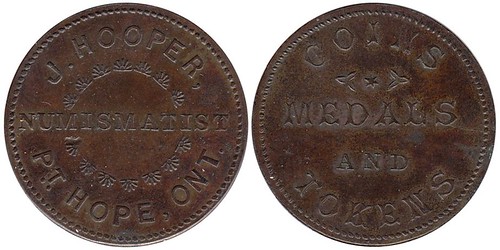
He issued a 28 mm copper store card struck by Pritchard & Andrews of Port Hope, Ottawa, Canada, Canada, with beaded borders on both sides with the obverse legend around the rim reading : J. HOOPER, PT. HOPE, ONT. and in the center of a circular repeated sunset patterns : NUMISMATIST, seven sunset patterns arcuated above and seven below. Reverse, around the beaded rim reading : COINS (top), TOKENS (bottom) and below the word COINS a device of a central six pointed star flanked on both sides by three leaves, and below MEDALS AND, (bottom) TOKENS.
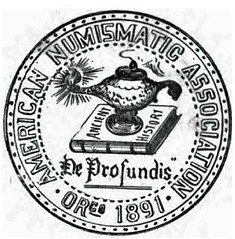 The ANA medal reverse designed in 1892 by Joseph Hooper. The reverse legend : TYPES OF EXTINCT CIVILIZATION. MORE HISTORIC THAN WRITTEN
HISTORY. The obverse has the book, oil lamp and legend DE PROFUNDIS, a pun on excavated coins. Around the obverse face is the legend : AMERICAN
NUMISMATIC ASSOCIATION ORG. 1891. The original drawing was presented to the ANA in 1933 by a son of Joseph Hooper.
The ANA medal reverse designed in 1892 by Joseph Hooper. The reverse legend : TYPES OF EXTINCT CIVILIZATION. MORE HISTORIC THAN WRITTEN
HISTORY. The obverse has the book, oil lamp and legend DE PROFUNDIS, a pun on excavated coins. Around the obverse face is the legend : AMERICAN
NUMISMATIC ASSOCIATION ORG. 1891. The original drawing was presented to the ANA in 1933 by a son of Joseph Hooper.
From October 1891 - December 1892 Hooper wrote a column for The Numismatist titled : “Numismatic Foundation Stones.” These were also printed separately as offprints or reprints in yellow wrappers from 1892-1893. Afterwards another column published by Hooper for The Numismatist was titled "Hooper's Restrikes". Besides these two regular columns Hooper published over two dozen articles for The Numismatist.
He donated part of his Greek coin collection to the Detroit Central Library, and another portion sold to the Dominion Government Museum. The remainder was divided among dealers and some were bequeathed to his children.
During the Annual Dinner of the Rochester Numismatic Association, January 18, 1916, Hooper is hailed as the "Grand Old Man" and referred to as the "oldest living numismatist" celebrating his 83d birthday the following month.
He died at the age of 86 on February 16, 1919, just three days prior to his 87th birthday at his home on 80 Emerson Street, Rochester, New York. He is buried at Mount Hope Cemetery, Rochester, New York.
Joseph Hooper was inducted into the ANA Numismatic Hall of Fame in 1974, fifty-five years after his demise. For the diamond jubilee of the ANA a medal was struck with the portraits of Hooper, Heath, and Jerrems, by Frank Gasparro.
To read the complete article, see:
HOOPER, JOSEPH
(https://sites.google.com/a/numismaticmall.com/www/numismaticmall-com/hooper-joseph)

PHOTOS OF STEPHEN NAGY
The November 12, 1909 New York Numismatic Club Photo
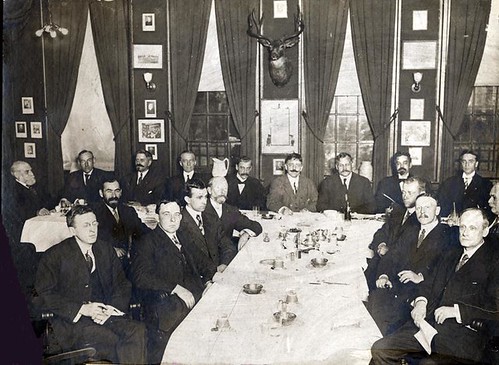
John Kleeberg writes:
Dave Hirt is quite correct. The man in the foreground in Lupia's cropped photo is Elmer Sears. The man in profile, behind him, is Stephen K. Nagy.
There is quite a lot more that could be written about Nagy. Nagy was involved in a remarkably large number of dubious numismatic transactions in the early twentieth century - 1913 nickels, territorial gold fakes (Massachusetts and California , USAOG, Templeton Reid). Pieces from his estate appeared in the 1958 ANA Auction conducted by Abe Kosoff. Eric Newman tried to get the dodgy pieces from the Nagy estate transferred to the Smithsonian; more details about that will be found in his correspondence.
Len Augsburger adds:
Regarding Nagy, there are a number of letters between John Ford and Eric Newman, c. 1958, in which Ford is attempting to get the Nagy estate placed in the Smithsonian. He wants Newman to donate money for it, and Newman is suspicious that Ford will siphon off some of the material. Newman ends up not funding the project. The most interesting document in the group is an inventory of the material, which would be interesting to compare to the Kosoff sale.
If I recall correctly, a group of drawings from George T. Morgan were part of this estate, went to Stack’s, and formed the basis for Karen Lee’s book on the subject, when they were eventually donated to SI. There were many other things in the estate.
John Kleeberg wrote:
This photograph also appears in Mehl's Numismatic Monthly, December 1909, page 194, and in The Elder Magazine, January 1910, page 14.
The date of the photograph can be determined from the dates given in Mehl's and Elder's magazines; and also from the fact that John H. Clapp appears, since he did not attend many meetings (he lived in Washington, DC).
Seated at the left of the front table, left to right: Wayte Raymond (glasses and cigar), Victor D. Brenner (bearded), Elmer Sears, Stephen K. Nagy, Bauman L. Belden (bearded, appears to have a water jug on his head)
Elmer Sears in Boston, 1921
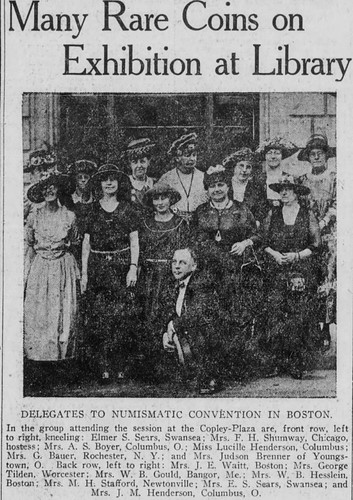
John Lupia writes:
Dave Hirt seems to be right that the cropped New York Numismatic Club photo originally posted by me is probably not zoomed in on Stephen Nagy but Elmer Sears. I found the above photo of Sears in the Boston Post, August 21, 1921. I replaced the photo with the other diner sitting next to him. I misread Dave Hirt's original notice in The E-Sylum or else I would have had it right. Thanks to Dave we have it!
1908 Philadephia ANA Photo
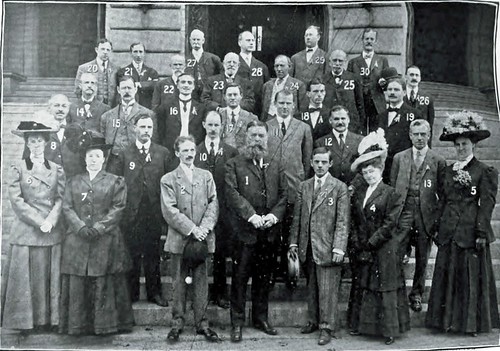
The Convention Group
Photographed on Main Entrance Steps, Philadelphia Mint,
October 1st, 1908.
1. Henry Chapman 2. Farran Zerbe 3. Howland Wood 4. Mrs. Farran Zerbe 5. Mrs. Henry Chapman 6. Miss Laura Collings 7. Mrs. Waldo C. Moore 8. Herbert Niklewicz 9. H. O. Granberg 10. F. G. Duffield 11. J. H. Clapp 12. E. H. Adams 13. D. A. Williams 14. George A. Larned 15. Thomas W. Voetter 16. R. L. Elder 17. W. S. Chattin 18. S. K. Nagy 19. Dr. J. M. Henderson 20. Elmer S. Sears 21. H. R. Newcomb 22. R. W. McLachlan 23. William Poillon 24. J. C. Mitchelson 25. M. Marcurorr 26. Henry Hammelman 27. George W. Devinny 28. T. Louis Camparette 29. Waldo C. Moore 30. Joseph H. Geis
Julia Purdy writes:
I did a Google search and found this interesting labeled 1908 ANA Convention photo posted by "leeg" at the Collectors Society forum. S.K. Nagy is listed as #18 and Elmer S. Sears as #20 in the photo. I know nothing more about this - just happened to come across it in my search.


Stephen Nagy in 1909 and 1908
To read the earlier E-Sylum articles, see:
NOTES FROM E-SYLUM READERS: JULY 10, 2016 : Stephen Nagy Photo Sought
(www.coinbooks.org/esylum_v19n28a09.html)
STEPHEN KENNETH NAGY, JR., (1884-1958)
(www.coinbooks.org/esylum_v19n26a15.html)
THE BOOK BAZARRE
MEDIALIA EXHIBITS HIGHLIGHT MODERN MEDALS
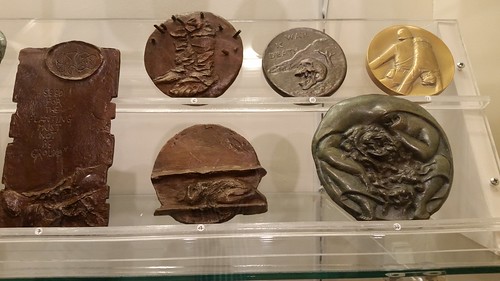
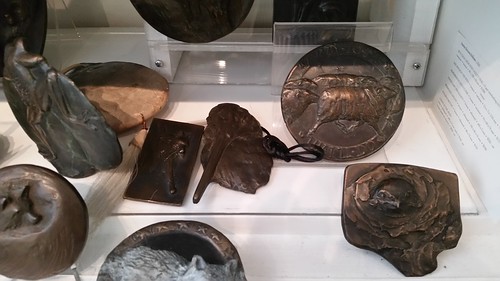
The Medialia Gallery in midtown Manhattan hosted a reception on July 16 to accompany “New Ideas in Medallic Sculpture, 2015-2016,” an international traveling exhibition. This eighteenth annual program features work from more than two dozen students from one Portuguese and one Japanese university.
The work, part of a longstanding effort of encouragement for young sculptors by gallery owner Mashiko, is the latest in a program begun during the 1998-1999 academic year when she was associated with the University of the Arts in Philadelphia.
At the same time the gallery is displaying more than one hundred medals and other art as part of a “microUniverse” collection. These include work by well-known artists, including Mashiko herself.
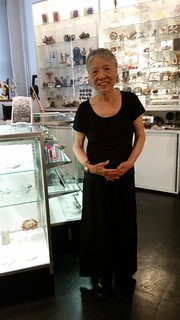
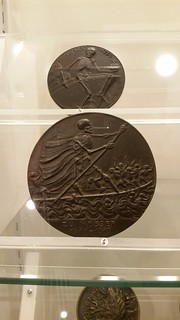
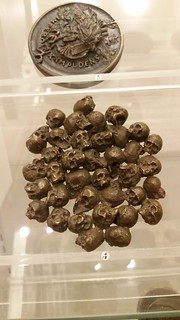
Gallery owner Mashiko; WeltkiegLandUnd; MilitaryWisdom
A third special collection, and one which especially impressed me, is entitled “Medals of War, Protest, and Peace.” This group of thirty-eight medals is from the collections of Dr. Jay Galst, Scott Miller (author of Medallic Art of the American Numismatic Society, 1865-2014), Normand Pepin, Dr. Ira Rezak, David Simpson and Frederic Withington.
Although many of these medals could be singled out, among the most notable are two rather eerie ones from the Simpson collection: Weltkieg Land Und, a 98-mm medal by Hans Lindl, a 1915 piece; and Military Wisdom, an especially haunting 115- by 90-mm work by Michael Reed, from 1995.
The gallery’s permanent collection of medals, most of which are for sale, includes those by such prestigious J. Sanford Saltus Award winners as Eugene Daub (1991), Mico Kaufman (1992), Leonda Finke (1997), Bernd Gobel (2000), Ron Dutton (2009) and Joao Duarte (2011).
More information on the gallery can be seen at:
http://medialiagallery.com/

MORE ON THE GOLD HENRY CLAY U.S. MINT MEDAL
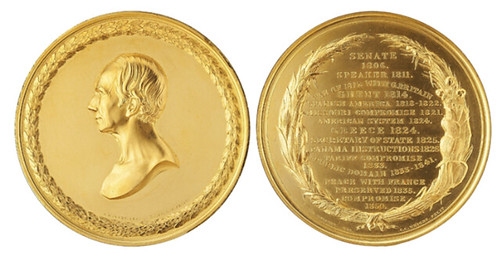
A nearly 30-ounce duplicate gold medal struck as a replacement for the medal originally presented in 1852 by citizens of New York to statesman Henry Clay but subsequently stolen will be offered at auction Sept. 17 in Dallas.
The committee of New York citizens commissioned the medal recognizing Clay’s achievements as “The Great Compromiser.”
The nearly half-inch-thick, 90-millimeter medal, struck by the U.S. Mint, is being offered in a “Lincoln and His Times” sale, a joint auction by Heritage Auctions and the journal The Rail Splitter in recognition of the 20th anniversary of The Rail Splitter’s May 18, 1996, sale in New York.
With gold closing on the London market July 14 at $1,323.60 per ounce, the intrinsic value of the gold medal, its precious metal value alone, is nearly $40,000.
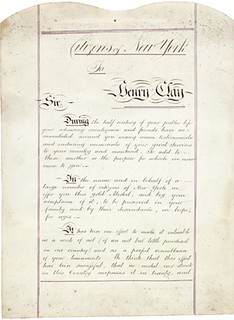 The medal, fabricated from pure California gold, is housed in what researchers conclude is a duplicate of the original engraved silver
presentation case, which resembles a hinged pocket watch. The medal and case are stored inside a box that has on its lid a colorized drawing of the
obverse of the gold medal as though housed in its silver case. Accompanying the medal is a letter announcing the reasoning for the presentation of
the medal.
The medal, fabricated from pure California gold, is housed in what researchers conclude is a duplicate of the original engraved silver
presentation case, which resembles a hinged pocket watch. The medal and case are stored inside a box that has on its lid a colorized drawing of the
obverse of the gold medal as though housed in its silver case. Accompanying the medal is a letter announcing the reasoning for the presentation of
the medal.
According to an article by Georgia S. Chamberlain in the January 1961 issue of the American Numismatic Association journal, The Numismatist, the gold for the medal cost $400, the silver casing $75, the cost of cutting the dies $1,600, and the cost of design and other “incidental” expenses, another $400.
Ohio sculptor Thomas Dow Jones is credited with executing the obverse design based on an 1850 bust of Clay by Mahlon Pruden, a sculptor from Lexington, Ky., from when Clay was 73 years old. Another Ohio sculptor, William Walcutt, rendered the reverse design for the gold medal.
The dies were cut at the U.S. Mint in Philadelphia by Charles Cushing Wright.
The obverse medallic portrait is encircled by a wreath. The reverse design depicts a wreath with cotton on one side and corn on the other, within which are inscribed Clay’s achievements in public service, including the Compromise of 1850, a series of laws dealing with the issue of slavery which staved off the American Civil War for 10 years.
According to R.W. Julian in Medals of the United States Mint: The First Century 1792-1892, Wright petitioned the Treasury Department in December 1851 and was granted permission to have the Clay medal struck in gold at the Mint.
Permission was subsequently granted for the production of 150 bronze duplicates. A single example is known struck in tin.
To read the complete article, see:
Nearly 30-ounce gold
Henry Clay medal anchors Sept. 17 auction
(www.coinworld.com/news/us-coins/2016/07/30-ounce-gold-henry-clay-medal-in-september-sale.all.html)
To read the earlier E-Sylum article, see:
GOLD HENRY CLAY U.S. MINT MEDAL OFFERED
(www.coinbooks.org/esylum_v19n25a19.html)

ALDRICH-VREELAND EMERGENCY CURRENCY OF 1914
Peter Huntoon writes:
A couple of issues ago you ran a piece contrasting American and British responses to the currency shortage caused by the outbreak of World War I and asked if anyone had anything on the Emergency Currency that was pressed into circulation here. As soon as you see the attached, you'll slap your forehead because it is hiding in plain sight! Perhaps your readers will find this treatise enlightening.
A crippling problem with national bank currency was that the supply of money was a fixed percentage of the capitalization of the national banks. Consequently, the volume of notes in circulation did not respond to the varying demands of business cycles. This problem doomed national currency, so the elastic federal reserve currency system was invented to replace it.
The concept that emerged is the following. As the demand for money increases, interest rates rise so banks can charge more interest on new national bank notes that they can draw against short term paper deposited as security. If the emergency increase in national bank note circulation is taxed at a higher rate, businesses can afford to pay the higher interest rates and the banks can in turn afford to pay the higher tax. However as business demand for currency falls, interest rates also fall, so the banks will reduce their emergency national bank note supply to avoid the higher tax.
THE ALDRICH-VREELAND ACT
Congress passed the Emergency Currency Act modeled on these principles, and it was signed into law May 30, 1908. The act is commonly known
as the Aldrich-Vreeland Act after its sponsors.
The Aldrich-Vreeland Act provided a mechanism that would permit banks to use securities other than U. S. government bonds to obtain short-term increases in their circulations. Two types of entities could apply for the additional currency: (1) groups of at least 10 banks formed into national currency associations and (2) individual banks.
National currency associations were authorized to accept securities from a member bank and then to apply to the Comptroller of the Currency for additional circulation for that member bank.
The total amount of emergency currency that could be issued under this act was set at $500,000,000. This amount was subsequently raised to over $1 billion by a hastily passed amendment dated August 4, 1914, immediately following the outbreak of World War I in Europe.
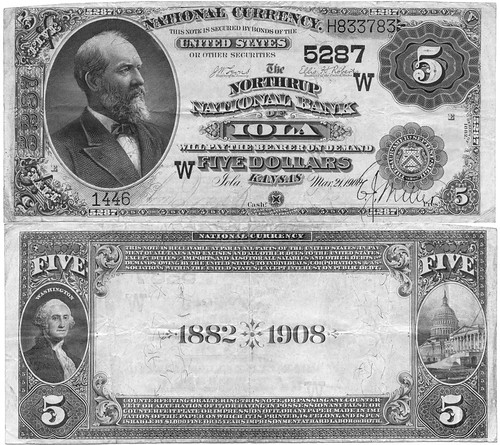
DATE BACK NOTES
The Aldrich-Vreeland Act explicitly addressed a number of details pertaining to all national bank note issues. The following denominations
were authorized: 5, 10, 20, 50, 100, 500, 1000 and 10,000. The security clause on the faces had to state "secured by United States
bonds or other securities." Highly significant was that the Comptroller of the Currency had to create a stockpile of such notes equal
to fifty percent of the capital stock of each national bank as soon as practicable. These requirements meant the Bureau of Engraving and
Printing had to alter the security clauses on all the existing Series of 1882 and 1902 face plates, design and prepare date back plates,
and print the enormous quantity of notes called for.
Very significant to numismatists was the fact that the Aldrich-Vreeland notes heralded the date back designs, most importantly causing the demise of our colorful Series of 1882 brown backs. The Secretary of the Treasury George B. Cortelyou addressed this change in his 1908 annual report, which you will find to be most interesting (Cortelyou, 1908, p. 45-46). The italics are mine.
It was deemed advisable, also, that the backs of these notes should bear some suitable inscription connecting them with the new act and differentiating them from previous issues. This was readily accomplished on the plates of the series of 1902 by adding the numbers "1902-1908," but as the series of 1882 had backs of an inartistic design, expensive to print, and bore the coats of arms of the different States, making it necessary to carry in stock a full supply for each State, it was considered to be an opportune time to prepare a new design for these backs, and new plates were accordingly prepared. This work commenced immediately after the passage of the act,
the first back plate altered in accordance therewith having been send to press June 5, and the first delivery of the new currency made to the Comptroller of the Currency June 15, showing commendable promptness on the part of the bureau in the prosecution of the work.
Work commenced at the Bureau immediately after passage of the act. Nearly 10,000 face plates had to be altered and $500,000,000 in notes printed as soon as possible (Bureau of Engraving and Printing, 1908, p. 4). The first altered face went to press on June 5, 1908, and deliveries to the Comptroller began on June 15 consisting of 5-5-5-5 Series of 1902 blue seal date backs, the first of which was the A1-1-A,B,C,D 5-5-5-5 sheet for The First National Bank of Beaver City, Utah (9119). The first Series of 1882 date back sheets were delivered to the Comptroller on August 1, 1908, including 5-5-5-5 and 10-10-10-20 sheets.
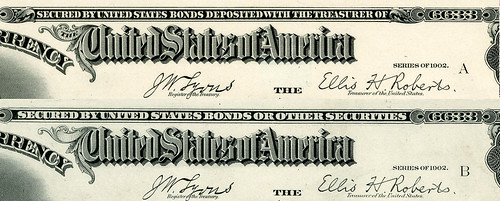
"... Or Other Securities" Clause Added
The production of the Series of 1882 and 1902 date backs was accomplished rapidly by altering the existing face plates by adding the "or other securities" clause and advancing the plate letters. For example, a 10-10-10-20 red seal plate with letters A-B-C-A was altered to carry plate letters D-E-F-B along with the revised security clause. The dates, 1902-1908, were added to the backs of the Series of 1902 plates, whereas new Series of 1882 back plates were prepared using only the borders from the previous brown back plates surrounding the 1882-1908 date. Both the treasury and bank sheet serials reverted to 1 for every sheet combination issued by every bank. No $500, $1000 or $10,000 notes were ordered by the banks, so plates for these denominations never were prepared for either the Series of 1882 or 1902.
EMERGENCY CURRENCY
The first national currency association was organized in New York on July 18, 1908 (Comptroller of the Currency, 1936). However, the fact
is no use was made of emergency currency before the original life of the Aldrich-Vreeland Act expired on June 30, 1914. When the provisions
of the Aldrich-Vreeland Act were extended for another year to June 30, 1915, no one expected the banks to take advantage of it.
World War I broke out in Europe at the beginning of August, 1914, and the situation changed radically. Kane (1922, p. 445-447), who at the time was serving as Deputy Comptroller, provides an insider's view of what transpired.
At this juncture the Aldrich-Vreeland emergency currency measure proved of great aid to the financiers and bankers. Although this law had been in existence since immediately following the panic of 1907, it had never been utilized and probably never would have been had it not been for the grave emergency created by the European war.
The Secretary of the Treasury realized the gravity of the situation, and on August 3 announced through the press that the Treasury Department was prepared to immediately issue to national banks in New $100,000,000 of additional currency authorized by this act.
The net impact of the emergency currency issues in 1914 and 1915 was to drive the total outstanding value of national bank notes to an all-time record number. The national bank note supply ballooned from about $700 million to $1.1 billion by the end of October, 1914. This circulation quickly contracted as the stringency passed owing to the high tax on the emergency issues.
DISCUSSION
Passage of the Aldrich-Vreeland Act on May 30, 1908, provided a mechanism that introduced elasticity into the national currency supply.
However, only the gravest financial crises could trigger applications for emergency currency because the tax imposed on the emergency
currency was too burdensome.
The result was that the provisions of the act were never invoked by the banks to provide elasticity as needed during the normal annual business cycle or the longer-term recession-inflation cycles that plagued the economy. Consequently, the national currency supply remained inflexible.
The fact was that no currency ever would have been issued under the terms of the Aldrich-Vreeland Act was it not for the extreme financial crisis precipitated by the outbreak of World War I.
Rather than tinker further with national bank currency, Congress established the Federal Reserve System in 1913, with its elastic currency, a move that ultimately rendered national bank currency obsolete.
But there were indeed some scrip notes issued during the panic of 1914; I've just never encountered them because they're so rare in comparison. I could have learned that just from the title of the recent book by Neil Shafer and Tom Sheehan on Panic Scrip of 1893, 1907 and 1914. Part III of the book, beginning on p337 covers 1914. Several states and the District of Columbia produced one or two scattered issues of scrip, some of which were Clearing House Certificates; others were from individual banks or companies. I've been unable to locate any images of these online, although a number are illustrated in black-and-white in the book.
Thanks, Peter, for your great explanation. Now it all makes some sense! Thanks also to Pablo Hoffman for sending the original article that kicked off this interesting discussion. -Editor
To read the earlier E-Sylum article, see:
PANIC SCRIP OF 1914 (www.coinbooks.org/esylum_v19n26a28.html)
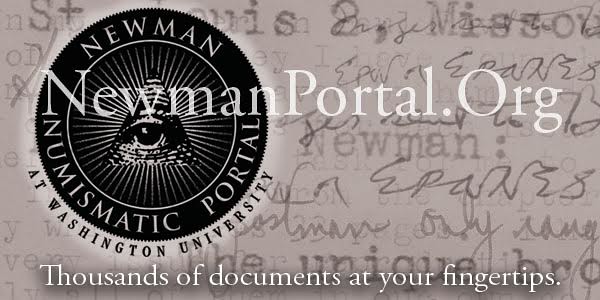
MACERATED CURRENCY SCULPTURES
Regarding the article about novelty company Archie McPhee's problems reselling macerated currency, Tony Terranova writes:
What they should have done was make papier mache, or paste out of it and get some decorative moulds and sculpt stuff.
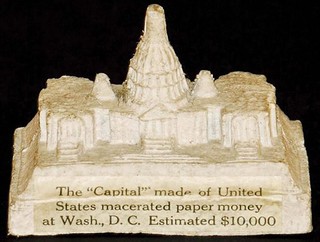
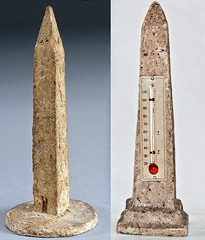
Souvenir buildings have been produced in a variety of materials. One of the most unusual has to be macerated money. Because it's the home of the U.S. Treasury, Washington, D.C. Landmarks are primarily represented. The Washington Monument, Lincoln Memorial, U.S. Capital, and the White House have all been molded from worn-out currency that has been chopped up. Other items made of shredded bills include postcards, shoes, medallions, axes, presidential busts, top hats, and more.
Paper currency did not come into general use until the Civil War. An act of Congress in 1862 authorized the Treasury Department to come up with a method for destroying old paper notes that were no longer fit for circulate. Between 1874 and 1942, the Federal Reserve disposed of worn-out currency by soaking it into a pulp. Enterprising people, who may have been early recyclers, discovered that the pulp could be used like papier-mache to form shapes. Souvenir companies bought macerated paper by the ton and the graded greenbacks were reborn. The process was discontinued when the Federal Reserve started burning old bills. Sometimes, the item was labeled with how much money was used to make the piece such as, "Made of U.S. National Greenbacks redeemed and macerated at the U.S. Treasury, estimated $5,000."
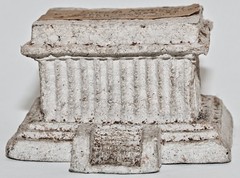
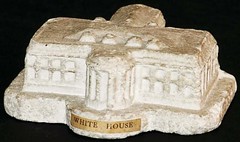
To read the complete article, see:
Macerated Money Souvenirs Landmarks of
Washington (www.buildingcollector.com/2014/07/macerated-money-souvenirs-landmarks-of.html)
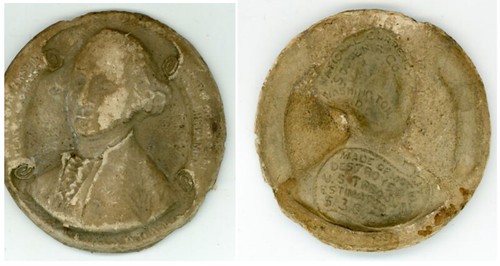
GEORGE WASHINGTON MACERATED MONEY MEDAL, ND. 91.6mm. VF/XF with surface abrasions and a few edge dents, as shown. Obv: Bust of Washington to partial left. A scroll is inscribed to either side: FIRST IN WAR, FIRST IN/PEACE, AND FIRST IN THE HEARTS OF/ HIS COUNTRYMEN. The reverse bears the following inscription in the intaglio portion of the bust: "NATIONAL CURRENCY SOUVENIR CO. WASHINGTON, D.C." and "MADE OF MONEY DESTROYED BY U.,S. TREASURY ESTIAMTED $3000." $95.00
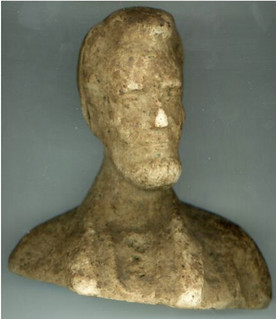 AN EXTREMELY LARGE MACERATED MONEY BUST OF ABRAHAM LINCOLN. 5 1⁄4" High. Base 5 3⁄4 x 3" . XF (The very white
area on the nose is a scanning defect – it does not appear that way in hand.) Here is a bearded bust of President Lincoln - one of the largest pieces
of macerated money art we have ever seen. The original paper label on the back is present but the inscription on it is no longer visible. $225.00
AN EXTREMELY LARGE MACERATED MONEY BUST OF ABRAHAM LINCOLN. 5 1⁄4" High. Base 5 3⁄4 x 3" . XF (The very white
area on the nose is a scanning defect – it does not appear that way in hand.) Here is a bearded bust of President Lincoln - one of the largest pieces
of macerated money art we have ever seen. The original paper label on the back is present but the inscription on it is no longer visible. $225.00
To read the earlier E-Sylum article, see:
PROBLEMS WITH RESELLING MACERATED CURRENCY
(www.coinbooks.org/esylum_v19n28a35.html)
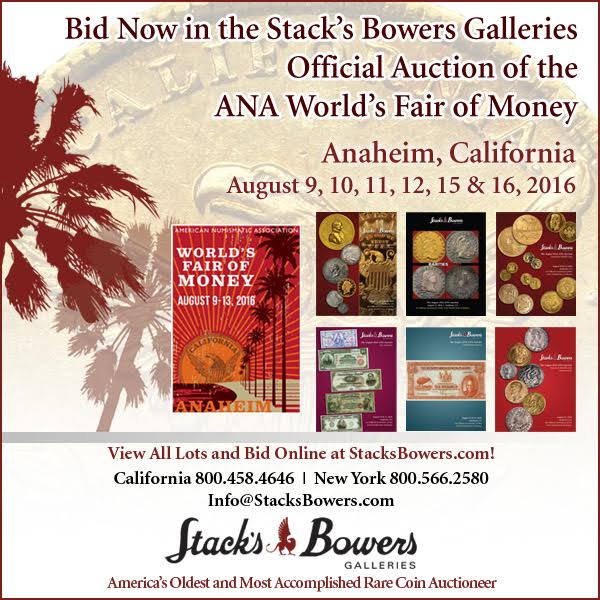
WAYNE'S NUMISMATIC DIARY: JULY 17, 2016
The months roll by fast. Tuesday July 12, 2016 was the meeting night of my northern Virginia numismatic social group, Nummis Nova. The night's host was Mike Packard, and he picked Four Sisters, a Vietnamese restaurant in Falls Church. I arrived early and won a hard-fought parking space in the building's garage. I was the first to enter the restaurant, but when I turned around to grab a seat at the bar, Eric Schena was right behind me and we took our seats while we waited for them to set up our table for dinner.
We lamented that Howard Daniel couldn't be with us. He lives half the year in Viet Nam, and might have helped with the menu. I lamented that our resident wine expert Gene Brandenburg wasn't with us yet. But I asked myself "What would Gene do?" and ordered a glass of Malbec from Argentina.
Christensen and Stone

Eric brought with him a set of Christensen & Stone mail bid sale catalogs. These two lady dealers from California (Alva Christensen and Ethel R. Stone) were active from the mid-1960s thru the early 70s, often selling medals. He was lending the set to me for the Newman Numismatic Portal. It will be a great complement to the medal literature already digitized, including the Presidential Coin and Antique sales from Joe Levine, and the MCA Advisory from the Medal Collectors of America.
Joe Esposito was the third to arrive and soon after we spotted Gene walking on the sidewalk outside. We were told our table was ready, and migrated to the dining room. Dave Schenkman was next, having dropped off Gene and gone to park his car. Dave sat to my left. Going around the table, other attendees Tuesday were Wayne Herndon, Steve Bishop, Julian Leidman, Joe Levine, Tom Kays, Mike Packard, and Ron Abler.
Spent By A Lawful Gun Owner
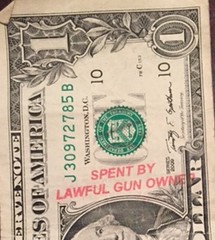 My show-and-tell items were sparse. I passed around my dollar bill with the "Spent By A Lawful Gun Owner" overstamp. We were all
surprised that I hadn't (yet) gotten any blowback from readers in light of the shootings in the news last week. E-Sylum readers are
generally good about sticking to numismatics. I'd actually written that item before the biggest flurry of news from Dallas. Thanks to Tom Kays
for this image taken at the dinner.
My show-and-tell items were sparse. I passed around my dollar bill with the "Spent By A Lawful Gun Owner" overstamp. We were all
surprised that I hadn't (yet) gotten any blowback from readers in light of the shootings in the news last week. E-Sylum readers are
generally good about sticking to numismatics. I'd actually written that item before the biggest flurry of news from Dallas. Thanks to Tom Kays
for this image taken at the dinner.
Am I Not A Man and a Centurian?
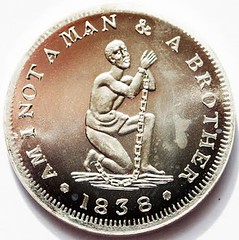
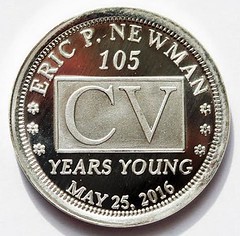
Images courtesy Dave Schenkman
The other item I brought was a silver medal made by Stu Levine in honor of our friend Eric P. Newman's 105th birthday. The "CV" of course, is 105 in Roman numerals. Coincidentally, my son told me this joke at home that night: "A Roman walks into bar, holds up two fingers and says, 'Five beers, please'"
The medal's obverse design is modeled after the famous anti-slavery Hard Times Token, one of Eric's favorites.
2015 Palau Treasure of the Cruel Captain $5
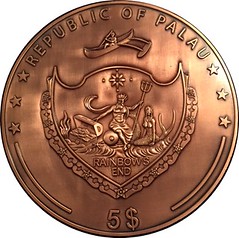
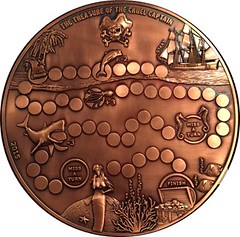
Images courtesy Tom Kays
I did NOT expect to see this at our meeting. Joe Esposito brought along this giant $5 "coin" from Palau. See my photo below for an appreciation of its size. Joe writes:
An increasing number of unusual coins identified with the Republic of Palau, a small archipelago nation in the western Pacific, have been released over the past decade. They include ones with a colorful natural history or architectural history theme, marine life (even one with an embedded pearl), and a sliver of emerald, sapphire, ruby or amethyst. There also is a unique biblical series. Most of these are 39-mm silver proof coins.
This high-relief 2015 coin, also unusual, is different: The diameter is 180 mm and it weighs a hefty 680 grams. Composed of an antiqued copper-zinc alloy, it is legal tender and denominated at $5. Palau uses U.S. currency, but it is highly unlikely that you would use this massive coin for a commercial transaction.
In addition to its amusing, commemorative character, this coin has a game on the reverse, “The Treasure of the Cruel Captain.” Although simple enough, using dice and markers, the two-player game is fun to play. It has a black, velvet-like pouch for easy transport.
The coin is identified as being “authorized by Palau Commemorative Coin Company.” It comes with a Certificate of Authenticity!
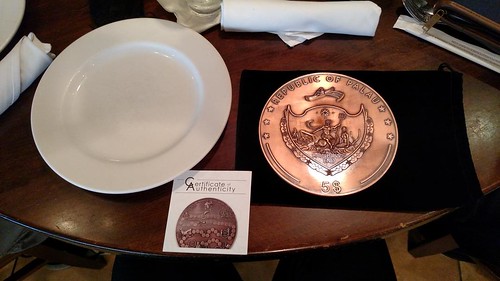
WWI German POW Trench Art Jewelry
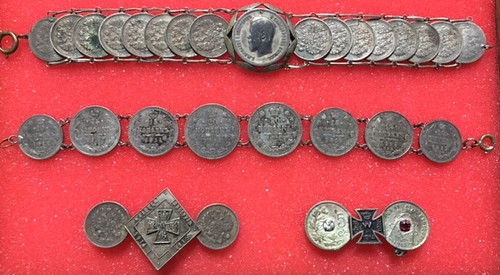
Tom Kays exhibited some interesting coin jewelery. He writes: "The story on my contribution of the WWI German POW jewelry made of Russian and Belgian coins, (Quotes from website: Trench Art of the Great War and Related Souvenirs by Jane A Kimball)."
“Trench art were made by soldiers, civilians, and prisoners of war during the Great War and afterwards. Trench art finger rings were produced in quantity from brass, aluminum, or silver coins. Regimental badges were made into pins and lockets, often called ‘sweetheart jewelry’ by soldiers and commercial firms to strengthen the bond between soldiers at the front and their loved ones at home.
"Prisoners of war on both sides produced an amazing variety of artifacts made for sale to soldiers or civilians in areas near camps in which they were interned. Some camps held artistic exhibitions in which these handicrafts were offered for sale to the public. Most are not signed.”
These examples, some with patriotic “Iron Cross” and with German abbreviations for “War Remembrance” were made by German POWs of pre-1917 Russian coins, plus one of Belgian coins with inset stones.
“Iron crosses were a popular motif for both allied and German trench artists. Thousands of pieces of trench art souvenirs brought home by soldiers and by tourists visiting battlefields after the war eventually drifted up to the attic or down to the basement as memories of the war faded. Many of the larger brass pieces were destroyed in WWII scrap metal drives.
"Unlike other collectibles, trench art does not significantly suffer from modern reproductions due to the extensive hand labor to make the items in the first place. Every piece of trench art is a unique artistic creation. This art form, born of blood and sacrifice, deserves much more attention than it has received to date.“
The 100th year anniversary of the Battle of the Somme brought these to my attention and I thought to share these newly matured “antiques” with you.
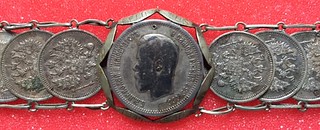
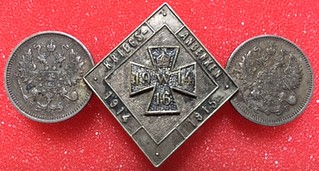
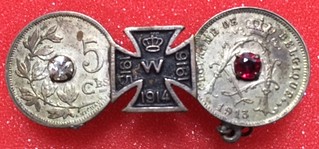
To visit the Trench Art web site, see:
www.trenchart.org
San Francisco Assaying & Refining Works Cambist
For bibliophiles, Eric Schena brought a rare and valuable Gold Rush era publication with a link to numismatics.
Eric writes:
I brought a nice copy of the San Francisco Assaying & Refining Works' Gold and Silver Tables Showing the Value per Ounce Troy, At Different Degrees of Fineness, and the Net Returns of Gold and Silver when Refined, also, Other Useful Tables Applicable to the Business of the Pacific Coast, printed in 1867 by Towne & Bacon’s Excelsior Book and Job Printing Establishment, 536 Clay St., San Francisco.
I have been fascinated in Gold Rush material for as long as I have been a coin collector (the private and territorial section of the Red Book was always my favorite as a kid) and have a very small collection of related ephemera.
In April 1855, John Glover Kellogg and Augustus Humbert established the assaying firm of Kellogg & Humbert at 106 Montgomery St. in San Francisco. Known today for the large number of ingots found on the S. S. Central America, Kellogg & Humbert also produced $20 gold coins under the Kellogg & Co. name in 1854 and 1855 to fill the immediate need for coins until the new San Francisco Mint could begin production in earnest. At some point, the firm moved to a larger location at 416 Montgomery St. where it would remain. The firm dissolved in 1860 following Humbert’s retirement from the assaying business.
Kellogg then formed a partnership with another assayer, John Hewston, Jr. to form Kellogg, Hewston & Co. Kellogg, Hewston & Co. continued until 1866 when Kellogg retired. The successor firm, the San Francisco Assaying & Refining Works, continued in business until 1875 when the Bank of California failed as a result of the Panic of 1873, when it closed and came into the possession of the Selby Lead & Silver Smelting Company.
The book of tables allowed for quick valuation of gold and silver per troy ounce based on assayed fineness of the metal. This, as well as a trio of bullion receipts by Kellogg & Humbert, Kellogg, Hewston & Co., and the San Francisco Assaying & Refining Works, are about as close as I will ever get to owning one of those magnificent Gold Rush ingots.
Gold Mountain Mining Scrip
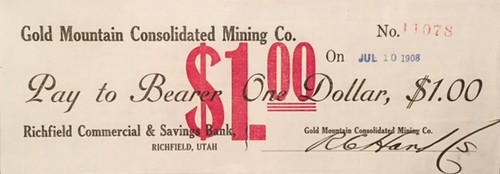
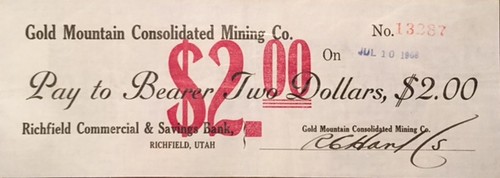
Images courtesy Tom Kays
Eric Schena writes:
The Gold Mountain Consolidated Mining Company $1 and $2 notes are neat examples of Panic of 1907 mining scrip. The effects of the Panic of 1907 were felt nationwide, including to the more remote mining districts in the American West. The Gold Mountain Consolidated Mining Company operated at the turn of the century in Piute County, Utah as well as at least two mines in Nevada.
The notes were issued in late 1907 but were payable on July 10, 1908. Richfield is the county seat of neighboring Sevier County and is the largest community in the area, hence the account's location at the Richfield Commercial & Savings Bank.
Of Cabbages and Kings, Admirals and Banjos
The conversations were delightful. I learned that Joe Esposito was planning a trip to New York and would visit the Medalia exhibit
discussed last week. See his report elsewhere in this issue.
I also quizzed Gene Brandenburg (who was drinking beer, by the way), showing him my wine glass and asking if he could predict what I'd ordered sans his usual help. He looked over the wine list and and said, "the Malbec from Argentina." I think I was the one who passed the test.
I forget how we got onto the topic of famous people we'd met, but some of us at least, are a nerdly bunch. Ron Abler told us he was on a lecture tour with "the woman who coined the the term "bug" for a computer glitch. "Grace Hopper?", I asked, to the blank stares of those around us. Grace Hopper was one of the first computer programmers of the modern era, rising to the rank of Admiral in the U.S. Navy. Ron had been in charge of rolling out the first shipments of personal computers in the Dept. of Defense, and he and Hopper were speaking about their experiences at government conferences around the country. She was in her 80s at the time.
My own nerdly brushes with fame include Internet pioneer Vinton Cerf and the man who invented the emoticon, those character-based forerunners of emoji indicating emotion in email. It was Scott Falhman, a red-headed leprechaun of a professor at Carnegie-Mellon University (look it up on Wikipedia).
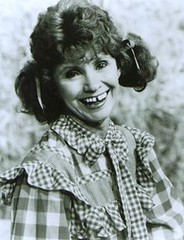
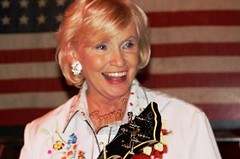
But proving that banjo players are way cooler than computer geeks, I think Dave Schenkman topped us all with his tales of playing with Hee Haw star performer and "First Lady of the Banjo", Roni Stoneman.
It was a great evening, as usual. I'm already looking forward to next month, when our post-ANA convention dinner will be hosted by Julian Leidman.
To read the earlier E-Sylum article, see: EXHIBIT: NEW IDEAS IN MEDALLIC SCULPTURE (www.coinbooks.org/esylum_v19n28a25.html)

NEW YORK’S USED BOOK STORES THRIVING
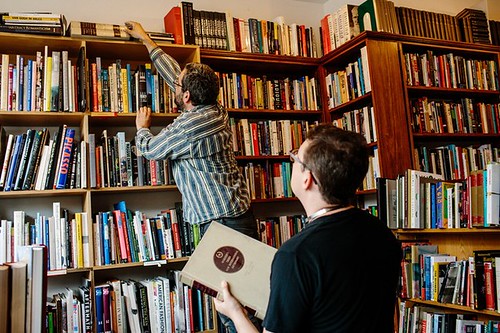
Little known fact: New York, the publishing capital of the world, is actually a collection of islands overlaying a slow-moving, subterranean tide of used books.
The relentless, inexorable flow of review copies, uncorrected proofs, used paperbacks and discarded textbooks swells and accumulates by the hour.
Is it any wonder, then, that the city’s used bookstores—the only agents gutsy enough to curate this terrifying onslaught—are thriving?
“There’s a used bookstore renaissance going on in New York City right now,” says Benjamin Friedman, co-owner of Topos Bookstore Cafe, in Ridgewood, Queens, one of several to open in recent years.
There are, by my count, more than 30 such shops in the city; more than 50 if you count the rare-book dealers.
They feed on the city’s discards. In New York, even the fiercest bibliophiles have limited shelf space. If you don’t weed your library on occasion, you’ll be buried alive. And given the current craze for material minimalism, book dealers say, folks are pruning their shelves more aggressively than ever.
As a result, it doesn’t cost much to stock a secondhand book store in New York. Shop owners say they will typically spend $1 to $3 to acquire a used book they can resell for $10, compared with $6 for a new book with a $10 list price.
“It’s very tedious, unpleasant work,” says Chris Doeblin, who sells a mix of new and used books at the 112th Street location of Book Culture, his Upper West Side mini-chain. “The labor you have to do for each one is crazy.”
The Strand, meanwhile, hosts a booming business selling and renting books “by the foot” to decorators, set designers and homeowners. Purchase rates range from $500 a foot for antique leather-bounds to $15 a foot for paperbacks.
Oversize art books, at $250 a foot, are the most popular option, says department manager Sky Friedlander. Some buy based on color, bringing in swatches to match. Popular shades include white and sea-foam green.
The newest shops, meanwhile, say they’re surprised by their success. When Topos opened in 2015, says Mr. Friedman, he thought the cafe would subsidize the bookstore.
“To our surprise, it’s been the other way around,” he says. “The books are doing really well.”
To read the complete article, see:
New York’s Used Book Stores Are Having a
Moment (www.wsj.com/articles/new-yorks-used-book-stores-are-having-a-moment-1468576802)
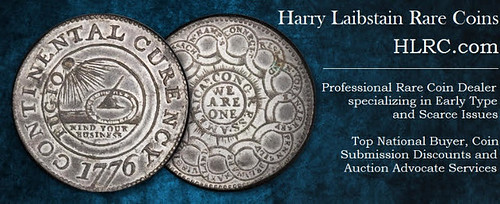
SELECTIONS FROM GEOFFREY BELL 2016 RCNA SALE
Lot 48: Ottawa/Carleton County Token - Br 784
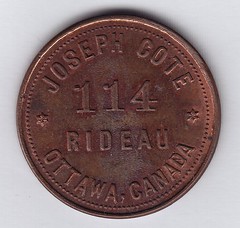
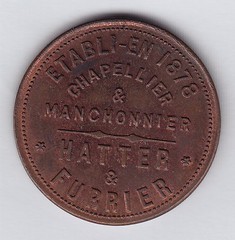
To read the complete lot description, see:
Ottawa/Carleton County Token - Br 784
(http://auctions.gbellauctions.com/Ottawa-Carleton-County-Token-Br-784_i24981542)
Lot 61: One Baden, Ont. Trade Token
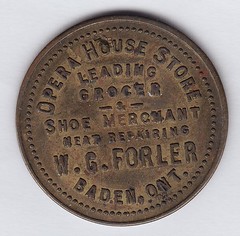

To read the complete lot description, see:
One Baden, Ont. Trade Token
(http://auctions.gbellauctions.com/One-Baden-Ont-Trade-Token_i24981555)
Lot 261: Br 517. Bees swarming across water
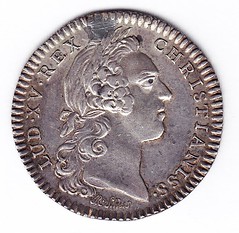
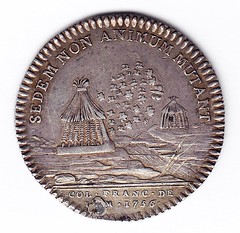
Br 517. - Bees swarming across water, east to west, symbolizing the emigration of Frenchmen to New France, 1756. Sedem Non Animum Mutant. (They change their homes, not their minds). Wilson Obv. Y, signed R. filius in script for Joseph Charles Roettier, fils. Frossard 41; Wilson Sale, lot 433; Gadoury 161. Silver. VF-EF, but holed and plugged at top of obverse.
To read the complete lot description, see:
http://auctions.gbellauctions.com/Br-517_i24981755
Lot 357: J.W. Millar Countermark on U.S. Quarter
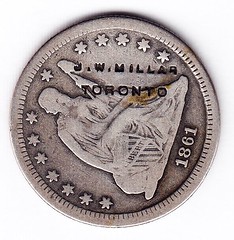
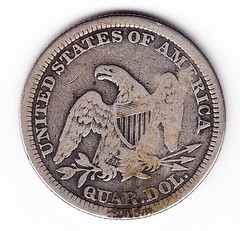
Canadian Countermark - J.W. Millar countermark on obv. of U.S. quarter dollar, 1861 (M.I. 655, Brunk M-659).
J.W. Millar, a watchmaker and jeweller, was first located in 1856 at 80 Yonge Street in Toronto.
To read the complete lot description, see:
Canadian Countermark
(http://auctions.gbellauctions.com/Canadian-Countermark_i24981851)
Lot 729: Lauzon Token
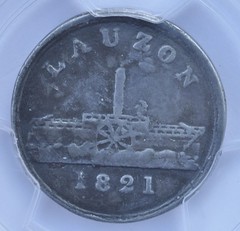
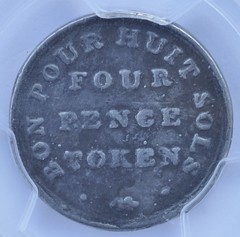
Lauzon Token Pair, 1821 - SUPERB RARITY - CH TR-2A. Br 560. PCGS VF35 & AU53 with a C/S JT. This is one of the earliest Canadian examples of a transportation token. The vessel on the token is the Lauzon, a 310-ton steam-powered side-wheeler. It was built and owned by John Goudie. The first steam-propelled vessel to make regular crossings of the St. Lawrence River between Quebec City and Levis. 2 Pcs.
To read the complete lot description, see:
Lauzon Token Pair, 1821 - SUPERB RARITY
(http://auctions.gbellauctions.com/Lauzon-Token-Pair-1821-SUPERB-RARITY_i24982226)
Lot 734: 1907 P.N. Breton Letter
 Numismatic Token Related Ephemera - P.N. Breton letter to C.W. Merritt of Norway, Iowa, dated November 8, 1907 advertising his new
catalogue supplement updating prices, etc. is available. The cost is $1.00, 6 copies for $4.00 or 12 copies for $7.00. A neat piece of early
Canadiana numismatic ephemera.
Numismatic Token Related Ephemera - P.N. Breton letter to C.W. Merritt of Norway, Iowa, dated November 8, 1907 advertising his new
catalogue supplement updating prices, etc. is available. The cost is $1.00, 6 copies for $4.00 or 12 copies for $7.00. A neat piece of early
Canadiana numismatic ephemera.
To read the complete lot description, see:
Numismatic Token Related Ephemera
(http://auctions.gbellauctions.com/Numismatic-Token-Related-Ephemera_i24982231)
Lot 745: Ludger Gravel Advertising Card
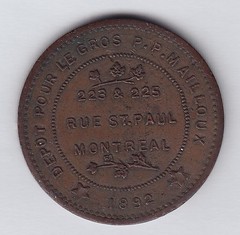
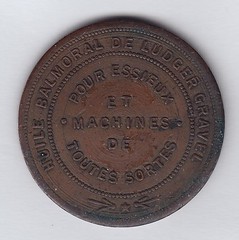
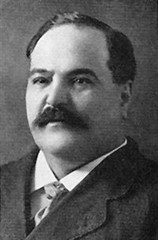 Gravel began collecting coins as a young man. By the mid-1890s, he was an active member and leader of the Numismatic and Antiquarian
Society of Montreal in 1895.
Gravel began collecting coins as a young man. By the mid-1890s, he was an active member and leader of the Numismatic and Antiquarian
Society of Montreal in 1895.
Joining the ANA in 1908, Gravel helped organize the ANA's 1909 convention in Montreal, the first held outside the United States. He also served as ANA librarian (1910-12), Board member (1921-22), chairman of the ANA's second convention in Montreal (1923), second vice president (1923) and first vice president (1924).
To read the earlier E-Sylum article, see: 2014 ANA NUMISMATIC HALL OF FAME INDUCTEES (www.coinbooks.org/esylum_v17n29a16.html)
To read the complete lot description, see:
Ludger Gravel Advetising Card
(http://auctions.gbellauctions.com/Ludger-Gravel-Advetising-Card_i24982242)
SELECTED SCOTTISH BANKNOTES FROM PAM WEST
1895 Caledonian Banking Company One Pound
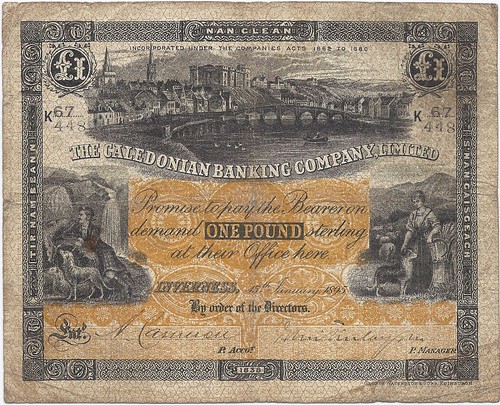
1939 Clydesdale Bank Five Pounds
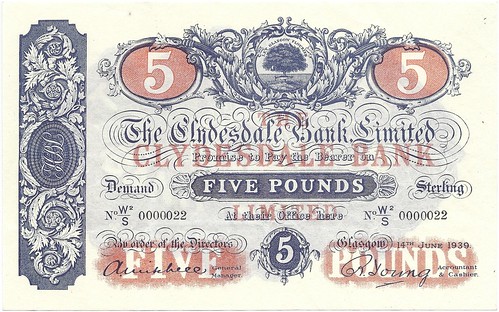
1966 Royal Bank of Scotland 100 Pounds
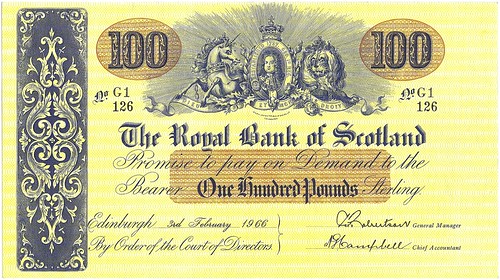
1977 Royal Bank of Scotland 100 Pounds
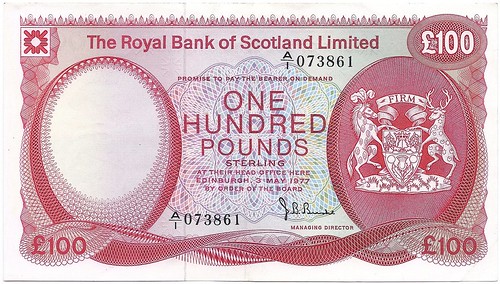
To visit Pam's web site, see:
http://britishnotes.co.uk/

THE COINAGE OF PERGAMON
NOW AND THEN IN HISTORY, economic, political and social forces come together in just the right combination to make a particular city the dynamic locus of cultural creativity. We see this in Athens in the time of Pericles (c. 495 – 429 BCE), Florence during the Renaissance (c. 1350 – 1450 CE), London in the reign of Elizabeth I (1558 – 1603), and Berlin during the Weimar Republic of the 1920s, to give but a few examples.
During the Hellenistic era (c. 323 – 30 BCE), Pergamon (or Pergamum[1]) was that kind of place. Art, literature, philosophy and science flourished amid magnificent architecture under the sensible and enlightened rulers of the Attalid dynasty for almost 150 years.
Alexander
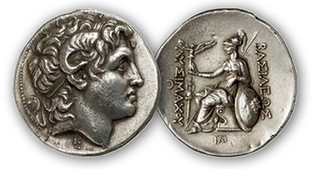 When Alexander the Great, aged 22, launched his conquest of the Persian Empire in 334 BCE, his debts amounted to 1,300 talents[3]. His
treasury had 70 talents on hand, and his army and fleet cost 200 a month to maintain. As he advanced, he requisitioned cash from the Greek cities of
Asia. A rare and beautiful series of anonymous gold staters may represent Pergamon’s contribution to his war chest (de Callataÿ).
When Alexander the Great, aged 22, launched his conquest of the Persian Empire in 334 BCE, his debts amounted to 1,300 talents[3]. His
treasury had 70 talents on hand, and his army and fleet cost 200 a month to maintain. As he advanced, he requisitioned cash from the Greek cities of
Asia. A rare and beautiful series of anonymous gold staters may represent Pergamon’s contribution to his war chest (de Callataÿ).
The obverse bears the familiar head of Herakles wearing the skin of the Nemean lion – a design that would appear on coinage in Alexander’s name for the next two centuries. The reverse bears a standing figure of Athena as goddess of war, holding spear and shield. This represents the idol in Pergamon’s temple dedicated to her. The design also appears on later silver diobols inscribed with Pergamon’s name.
Philetairos
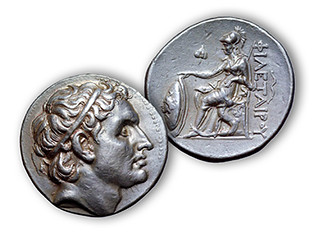 As a Seleucid client state, Pergamon was semi-independent. Philetairos ruled wisely for almost 20 years, establishing a network of regional
alliances and improving his city with monumental architecture and strong defenses.
As a Seleucid client state, Pergamon was semi-independent. Philetairos ruled wisely for almost 20 years, establishing a network of regional
alliances and improving his city with monumental architecture and strong defenses.
Years after the assassination of Seleucus (shortly after his victory against Lysimachus in 281 BCE), Philetairos placed an idealized portrait of Seleucus on the city’s coins but inscribed his own name without title on the reverse. When he died in 263 he left his nephew, Eumenes, in charge of a thriving and prosperous state.
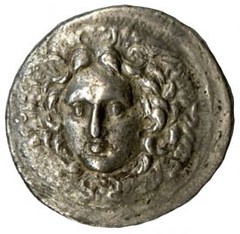 Eumenes II
Eumenes II
Eumenes II continued to strike silver tetradrachms bearing the portrait of Philetairos with an Athena reverse, but two incredibly rare
types are also attributed to his 38-year reign (197 – 159 BCE).
Three examples are known of a tetradrachm, issued about 180 BCE, depicting the head of Medusa in a “3/4 facing view” – a
technically-challenging orientation first used by the great coin die engraver Kimon of Syracuse circa 410 BCE
Pergamon under Roman Imperial Rule
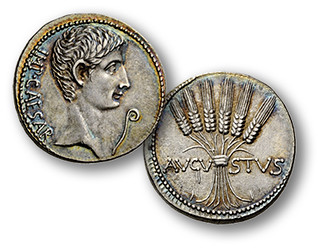 When Attalus III, Pergamon’s last king, died without a successor in 133 BCE, he bequeathed his kingdom to the Roman Senate. In this fashion
Pergamon continued to thrive as the capital of the Roman province of Asia (the capital later moved to Ephesus). Cistophoric tetradrachms now bore the
names of Roman magistrates. Emperor Augustus placed his own portrait on Pergamon’s coins, with a reverse showing six ears of grain. This type is
rare, because most of them were overstruck a century later by Hadrian (117 – 138 CE).
When Attalus III, Pergamon’s last king, died without a successor in 133 BCE, he bequeathed his kingdom to the Roman Senate. In this fashion
Pergamon continued to thrive as the capital of the Roman province of Asia (the capital later moved to Ephesus). Cistophoric tetradrachms now bore the
names of Roman magistrates. Emperor Augustus placed his own portrait on Pergamon’s coins, with a reverse showing six ears of grain. This type is
rare, because most of them were overstruck a century later by Hadrian (117 – 138 CE).
To read the complete article, see:
CoinWeek Ancient Coin Series: Coinage of
Pergamon (www.coinweek.com/ancient-coins/coinweek-ancient-coin-series-coinage-pergamon/)

THE IMPERIAL FAMILY ON ROMAN COINAGE
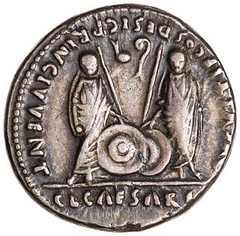
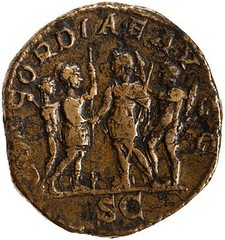
Coins played a significant role in shaping the public image of the Roman imperial family. The majority of the coins which left the central imperial mints featured the emperor himself and emphasized his activities and virtues, from (re)conquering Britain to his close friendship with Hercules. However, emperors did not always appear solo on their coinage- wives, ancestors, and descendants could all be placed on coins to highlight other marks of distinction for the regime, such as proclaiming ancestry or demonstrating the security of the succession. Although there has recently been a great deal of interest in the place of members of the imperial house on coinage, one aspect which has been largely ignored is the development of familial types – coins which display at least two members of the imperial family together on either the obverse or reverse of a coin.
These types appear early on – Augustus minted coins with his chosen successors, Gaius and Lucius Caesar, together on the reverse. By the end of the reign of Septimius Severus (193-211), familial types had become more common. This is in large part due to the prominence of his two potential heirs, Caracalla (198-211) and Geta (209-211), and their powerful mother, Julia Domna.
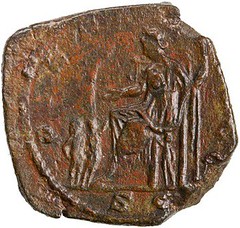 The members of this imperial household were mixed and matched to produce a variety of familial types. The most common familial types depict
Severus’s sons on the reverse, usually with a legend emphasizing concordia, or harmony. This may have been intended to reinforce the dynasty’s
stability to the people of the empire, though it may also have been an unsubtle message from the imperial court to a pair of brothers who were
notoriously always at odds.
The members of this imperial household were mixed and matched to produce a variety of familial types. The most common familial types depict
Severus’s sons on the reverse, usually with a legend emphasizing concordia, or harmony. This may have been intended to reinforce the dynasty’s
stability to the people of the empire, though it may also have been an unsubtle message from the imperial court to a pair of brothers who were
notoriously always at odds.
To read the complete article, see:
THE IMPERIAL FAMILY ON THIRD CENTURY ROMAN COINAGE
(www.anspocketchange.org/caldis/)
THE BOOK BAZARRE
BANK OF ENGLAND PROMOTES NEW POLYMER NOTE
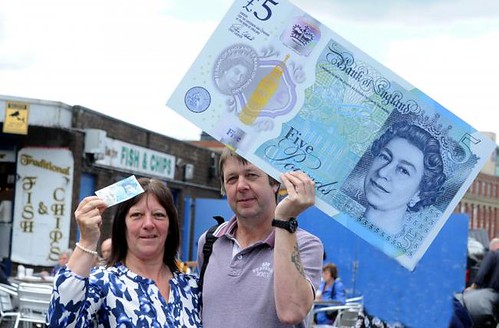
BRITAIN'S first plastic banknote was showcased – at Bury Market.
The new plastic £5 note, which is printed on a thin film called polymer, was shown to shoppers on Wednesday.
Visitors to the market were able to see and touch the new note which is a significant move away from the paper notes which have been used for more than 300 years.
The new fiver feels different to the notes currently in circulation and is 15 per cent smaller with a number of new security features.
The Bank of England is keen to make sure that the public are familiar with the note before it goes in to circulation on September 13 and Bury Market was the first place it was showcased. The new note is resistant to dirt and moisture which means that it will remain in better condition for longer.
It is expected that it will last two and half times longer than the current note.
To read the complete article, see:
Britain's first
plastic bank note showcased at Bury Market (www.burytimes.co.uk/news/14616306.Britain__39_s
_first_plastic_bank_note_showcased_at_Bury_Market/)
STUDY SHOWS POLYMER BANKNOTES RETAIN FINGERPRINTS
New research into the most effective way of lifting fingerprints from polymer banknotes has been led by scientists at Loughborough University.
In September 2016, the Bank of England will introduce a new £5 polymer banknote into circulation. The following year, the same thin and flexible plastic material will be used for a new £10 note, and by 2020, new £20 notes will also be made available.
Developing fingerprints from this new surface represents an important forensic challenge as current imaging protocols for paper currency will potentially become redundant once the new notes are issued.
This preliminary investigation into the recovery of fingerprints from precursor test notes has successfully demonstrated that fresh latent fingerprints, not immediately visible to the naked eye, can be developed using elemental copper deposited via a highly sensitive technique known as vacuum metal deposition (VMD). The results can then be imaged using near-infrared illumination. In addition, a forensic gelatine sheet can be used to lift from the treated note's surface and then the fingerprints revealed to the naked eye by spraying the sheet with rubeanic acid -- a development reagent -- which reacts with the copper to produce a visually distinguishable fingermark.
"The next stage of our research will be to see if this new and versatile twist to traditional VMD techniques can be used to enhance fresh fingermarks on other pertinent polymer-based materials, such as carrier bags. We would also like to investigate the possible effect of wear and tear on the VMD development process when analysing handled polymer banknotes.
The study entitled "Visualisation of latent fingermarks on polymer banknotes using copper vacuum metal deposition: A preliminary study" has been published in Forensic Science International.
To read the complete article, see:
Scientists trial fingerprint development method for Britain's
new polymer banknotes (www.sciencedaily.com/releases/2016/07/160713102943.htm)

BENNY BUCKS: MYSTERY DONOR HIDES $100 BILLS
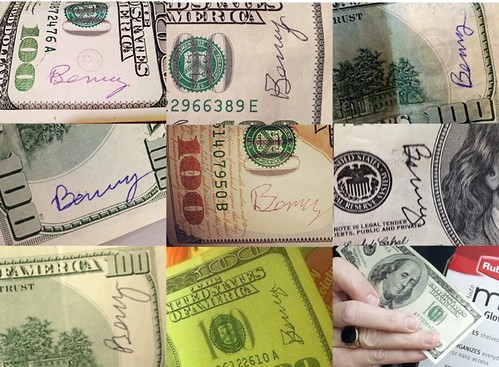
It happened two summers ago, as Joe Robinson was marking down the prices on the pots he was selling at a fine arts festival in Oregon.
“I pick pots up by the rim, flip them upside down, see if the price looks right, maybe cross it out, put something else,” Robinson told The Washington Post on Friday.
Regular, everyday stuff, you know? On that day in 2014, though, he picked up a pot that had an imprint of a fern on it.
He flipped it over.
And as he did, out dropped a $100 bill, upon which a name was written: “Benny.”
“It was a brand-new, crisp $100 bill that had obviously never been in circulation,” Robinson said. “So that mark was pretty obvious on it.”
Robinson figured it was some kind of mistake. Maybe someone dropped it by accident when they were making a purchase earlier in the day.
Because you don’t just find a hundred bucks, right?
But remember that name on the bill? It indicates the money came from a person known simply as Benny — a mysterious philanthropist who has anonymously hidden hundreds of $100 bills over the past few years.
And the people Robinson spoke with after finding the cash knew all about it.
“Everyone had some kind of a story,” Robinson said. “And so I guess it’s his thing to do crisp, brand-new bills.”
“Benny” hides those $100 bills all over the place in Salem, Ore., and the surrounding area, reports have indicated. They have been discovered in the pockets of clothing, in diapers, in baby wipes and in candy, Capi Lynn, a columnist for the Statesman Journal, said in an email.
There was the girl who found a Benjamin in a pink bank purchased by her mother.
“I shook it, and it popped out of the hole,” the girl said. “My mom thought it was fake, but it was real.”
And the woman who found one with a package of cereal, right when she truly needed it.
In another instance, Benny’s gift was discovered by an 8-year-old boy who found the cash in a store’s toy bin. The newspaper reported that the boy and a friend who was with him would use the cash to buy toys.
But not for themselves. The plan was to donate the haul to a children’s group. What’s more: Their parents were expected to match Benny’s gift, according to the Statesman Journal.
This is a thing that happens a lot, said Lynn.
Benny, she wrote, has “launched a pay-it-forward spirit in the community.” By her estimation, more than half of those who find his $100 bills end up “paying it forward” — either to a charity of their choice, a cause dear to their heart or just to a person or family needing it.
To read the complete article, see:
(www.washingtonpost.com/news/inspired-life/wp/2016/07/16/benny-the-mystery-philanthropist-hides-100-bills-so-far-hes-given-away-more-than-55000/)
FBI CLOSES D.B. COOPER CASE
The last time anyone saw D.B. Cooper, he parachuted out of a Mexico City-bound airplane with $200,000 in ransom strapped to his body, vanishing over the Pacific Northwest and initiating one of America's greatest manhunts.
Forty-five years later, the FBI is closing the books on this unsolved case.
"We have arrived at our conclusion today that it was just time to close the case because there isn't anything new out there," said Special Agent in Charge Frank Montoya, Jr. "There's a lot that goes into that decision but really it was just time."
The infamous hijacking that took place in 1971 became one of the bureau's "longest and most exhaustive investigations," the FBI said.
"If something were to arise -- principally the parachutes or the money -- you know, we would reopen, we would look into this, we would do what we could to bring the perpetrator to justice. But at the same time, after 45 years we just don't think that that's likely," Montoya said.
Whether "D.B." -- a name created by the press, according to the FBI -- survived the 10,000 foot plunge into the wilderness has never been confirmed, and his true identity has never been determined.
The evidence collected over the years will now be preserved for historical purposes at the bureau's headquarters in Washington, D.C., the FBI said.
One clue came in 1980, when a boy found a rotting package of $5,800 in $20 bills that matched the serial numbers of the ransom money.
To read the complete article, see:
D.B. Cooper: FBI closes the books 45 years after skyjacking
mystery (www.cnn.com/2016/07/12/world/d-b-cooper-fbi-closes-case/)
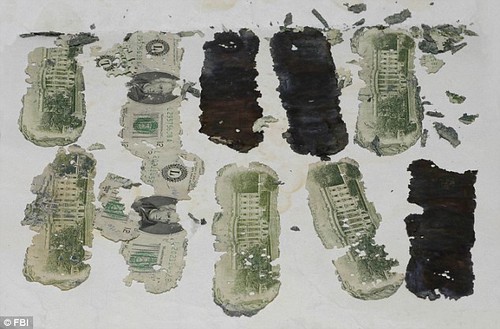
To read earlier E-Sylum articles, see:
D. B. COOPER: WHERE IS YOUR LOOT? (www.coinbooks.org/esylum_v04n48a07.html)
D. B. COOPER CASH STASH FOR SALE (www.coinbooks.org/esylum_v10n06a11.html)
DISTRIBUTION OF THE KNOWN D.B. COOPER BILLS
(www.coinbooks.org/esylum_v10n07a16.html)
D. B. COOPER MYSTERY CONTINUES (www.coinbooks.org/esylum_v18n48a43.html)
FEATURED WEB SITE: THE BODE MUSEUM
This week's Featured Web Site is the numismatic collection of the Bode Museum in Berlin.The Numismatic Collection is one of the most important numismatic collections in the world. It provides its holdings mainly in the Bode Museum on the Museum Island Berlin from. Here the Numismatic Collection, the history of mankind vividly illustrate the centuries-old mass communications coin. In addition, it enriches the vision of the Antiquities Collection in the Altes Museum with a selection of his best pieces of ancient coinage. Besides coins include medals of the essential objects of the Numismatic Collection. In addition, there are paper money, seals, brands and Rechenpfennige, nichtmünzliche money forms and historical minting the mint Berlin in his extensive holdings.
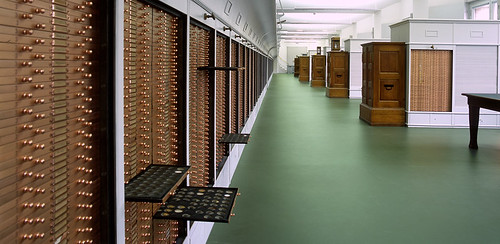
www.smb.museum/museen-und-einrichtungen/muenzkabinett/ueber-uns/profil.html

